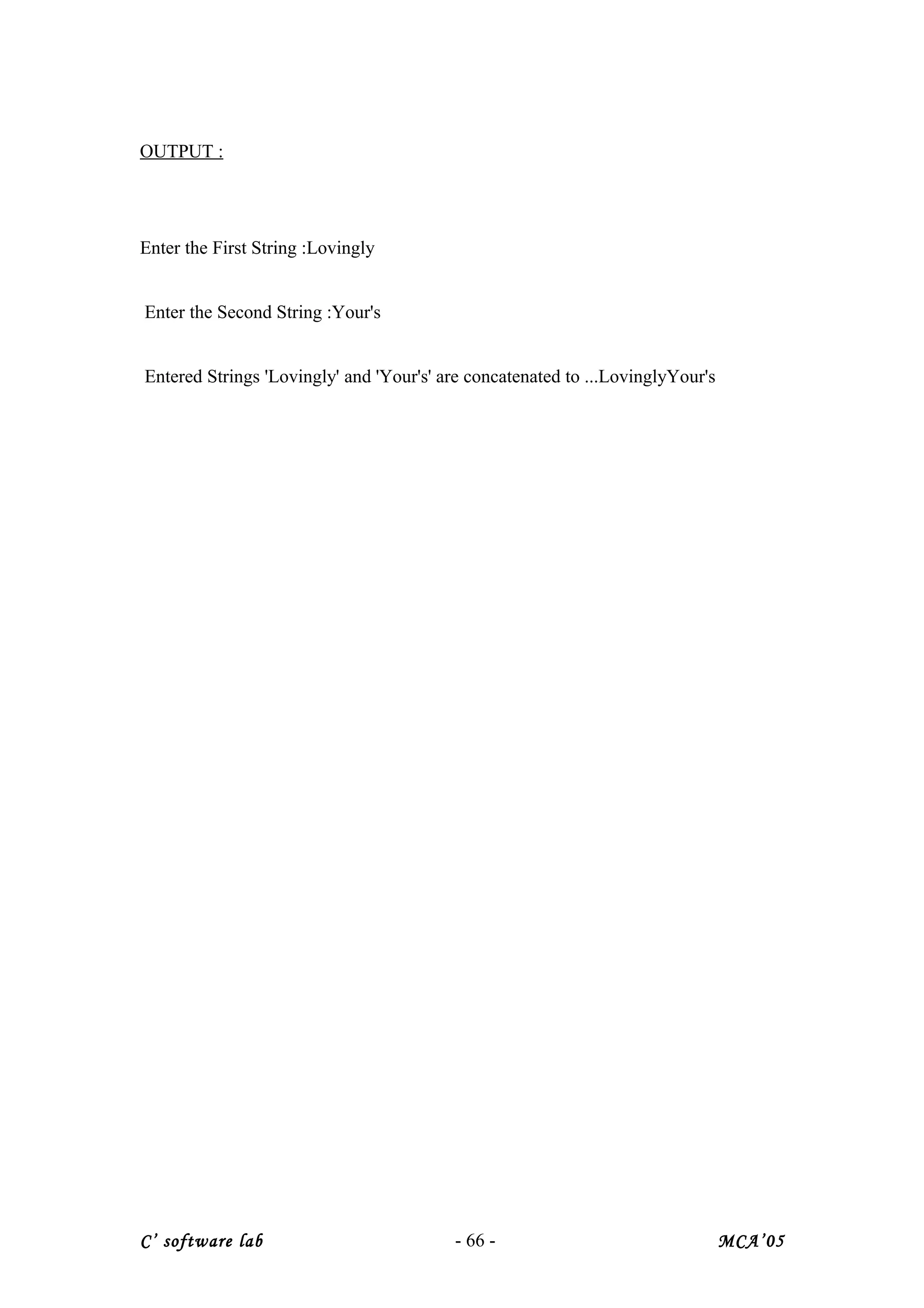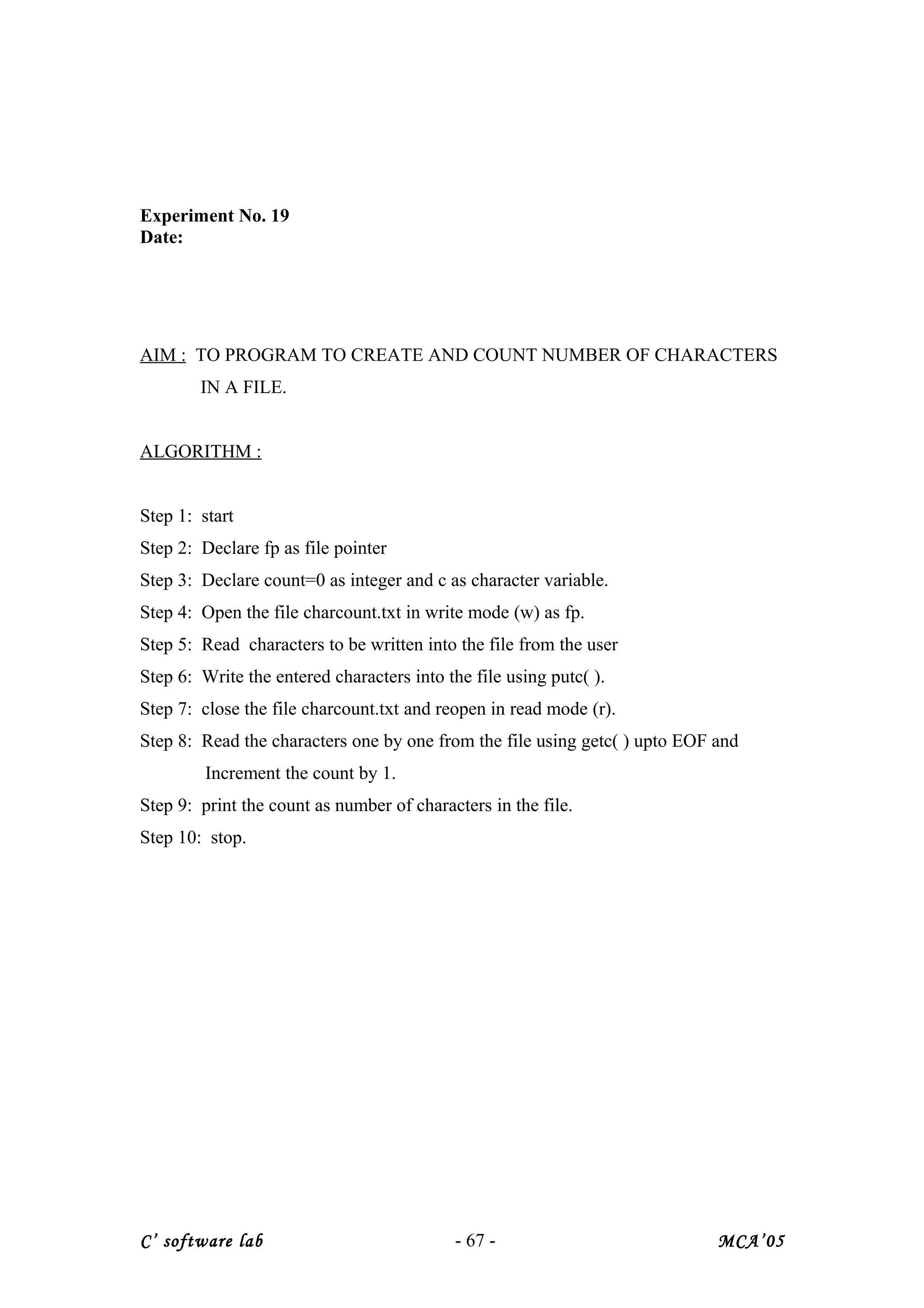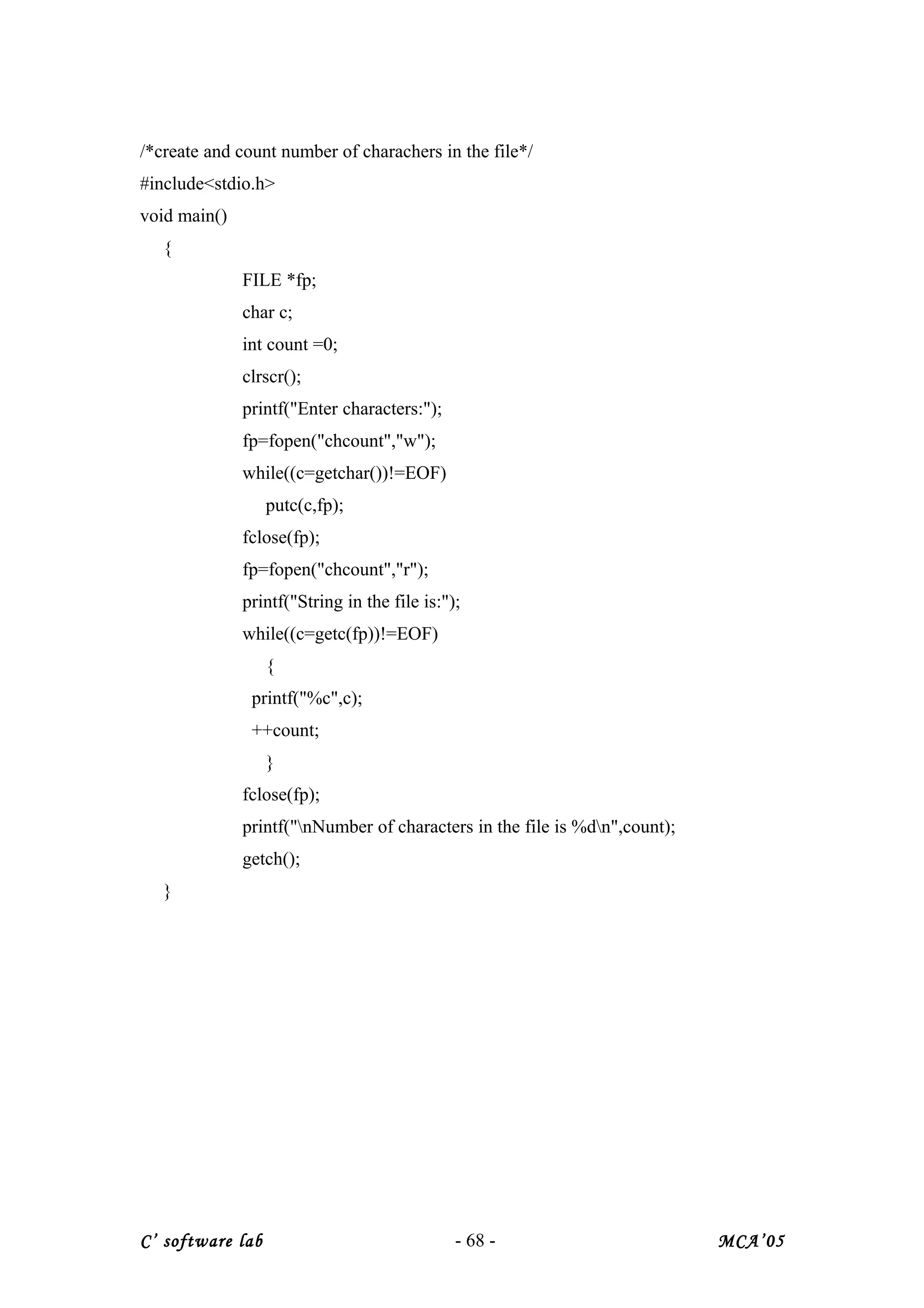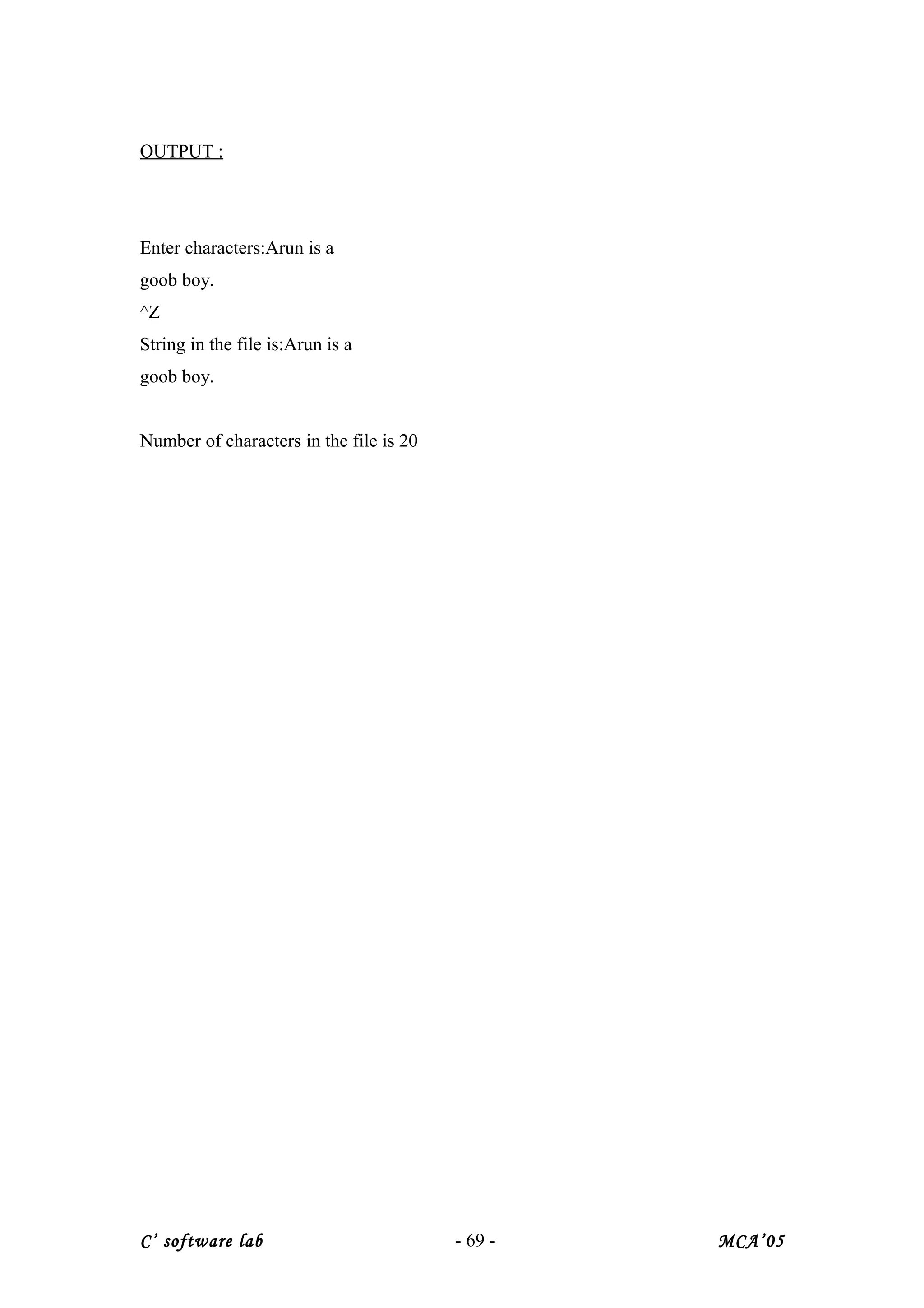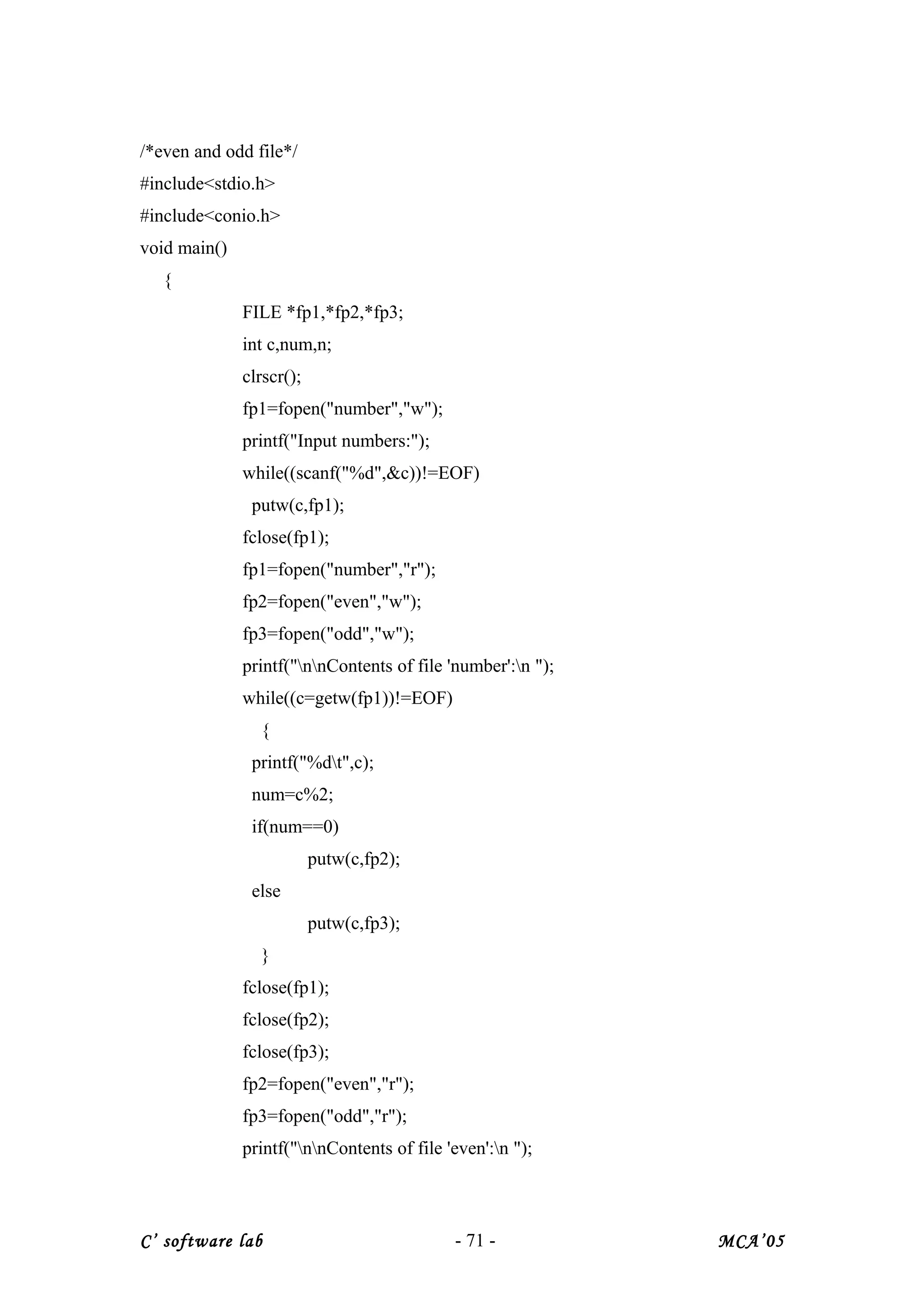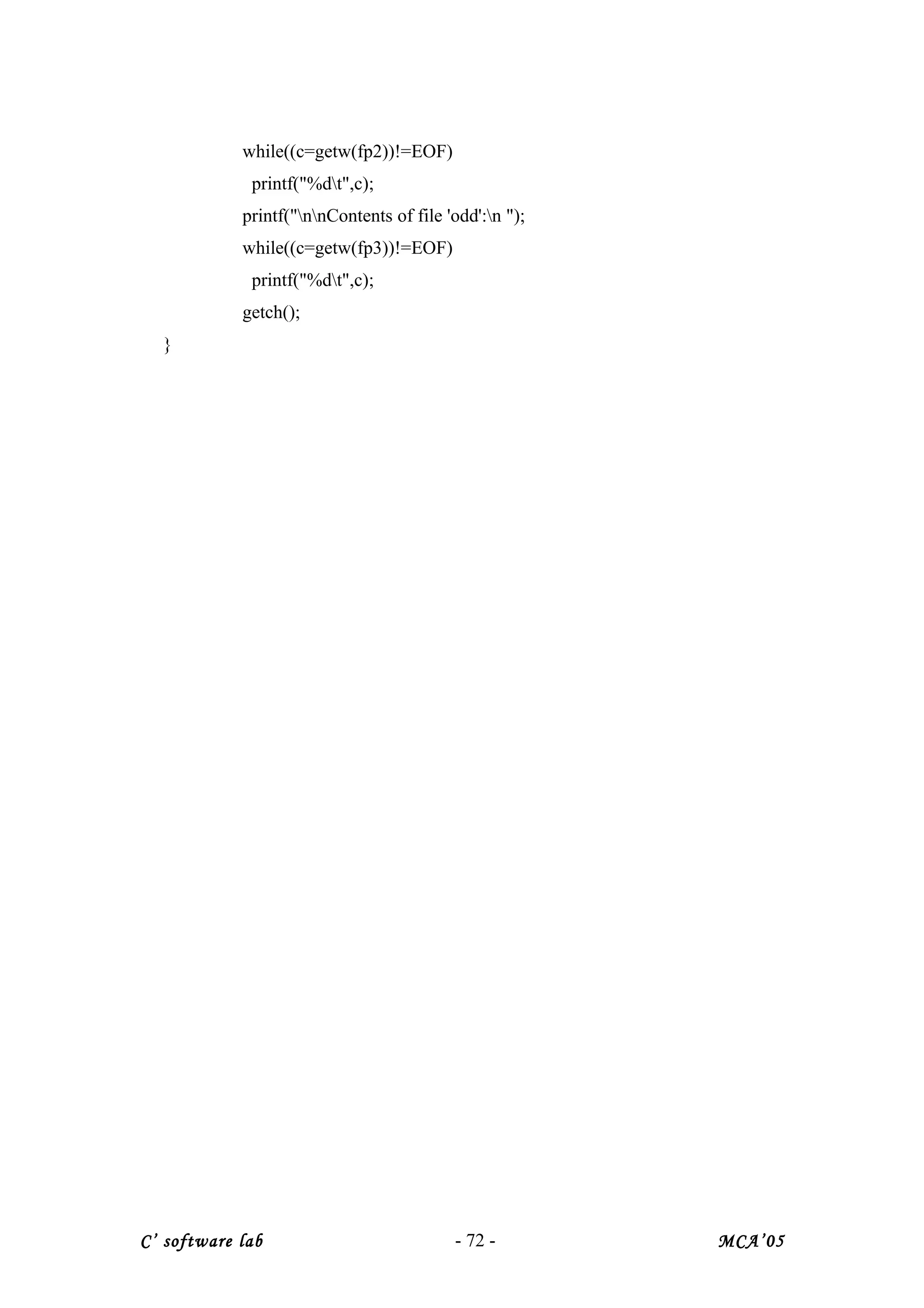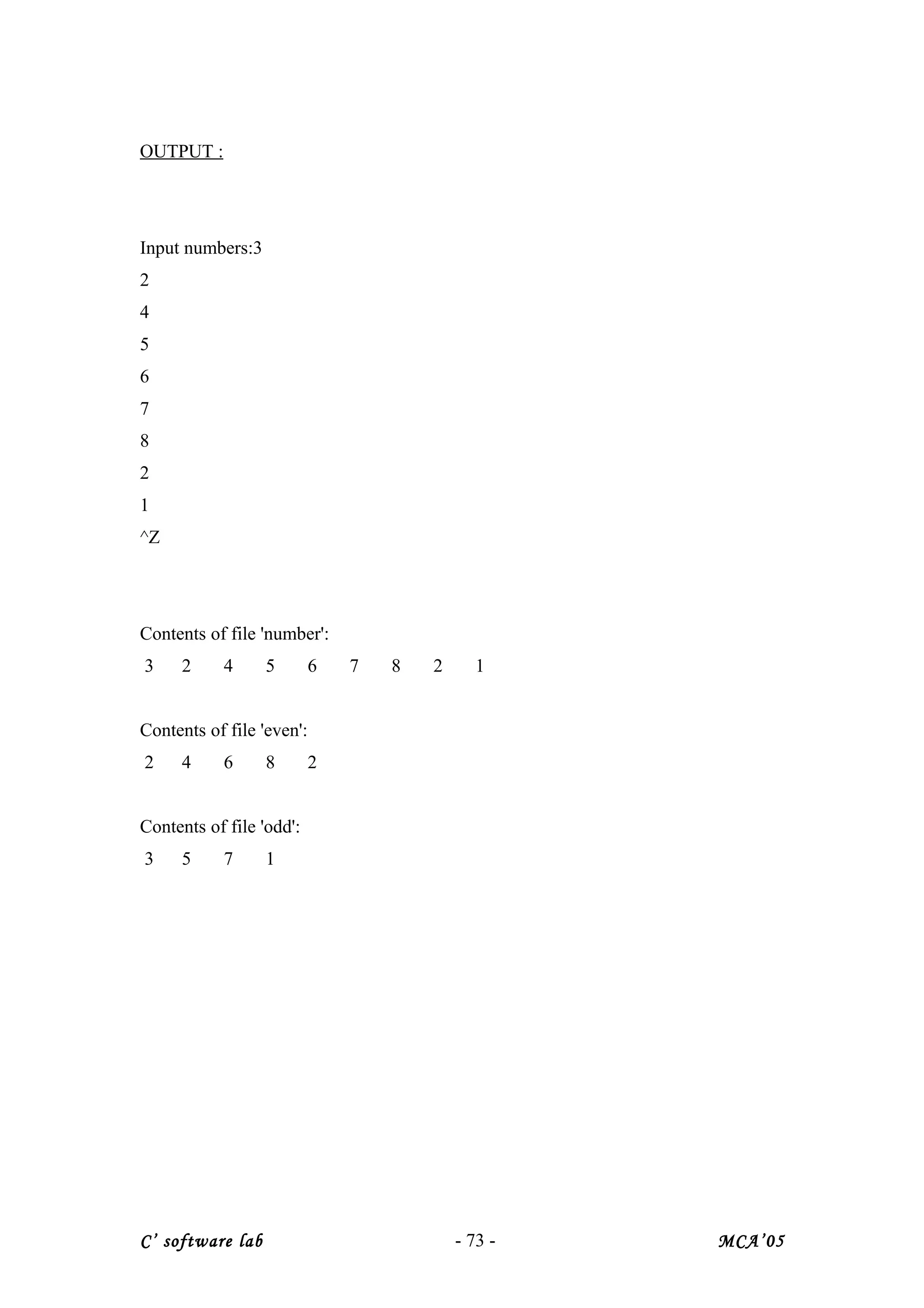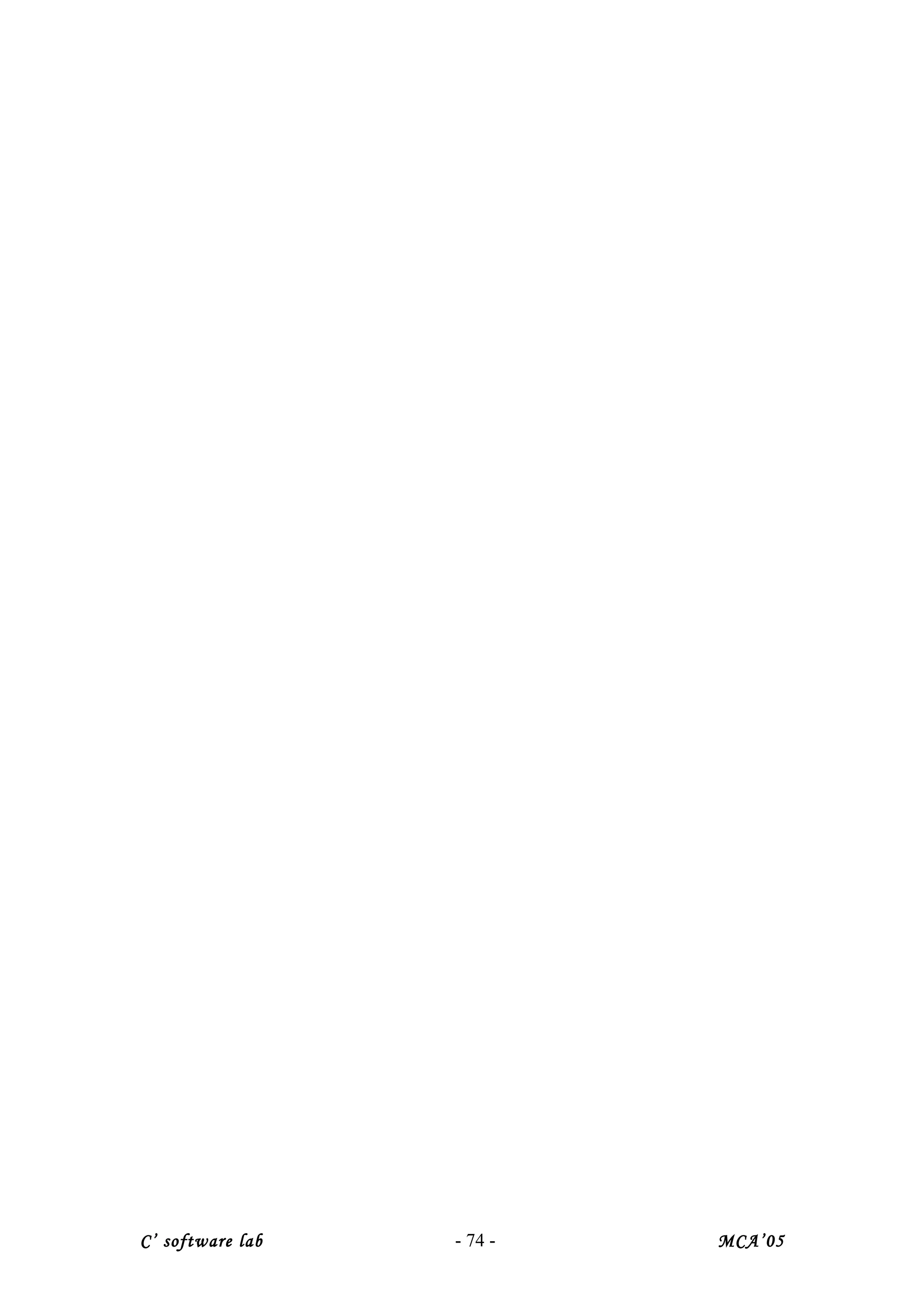1. The document contains code for 8 programming experiments involving algorithms for calculating simple and compound interest, determining Armstrong and Fibonacci numbers, finding the roots of a quadratic equation, matrix operations, and sorting arrays.
2. The algorithms are presented step-by-step and the C code to implement each algorithm is included and commented.
3. Sample inputs and outputs are provided for each program to demonstrate its functionality.




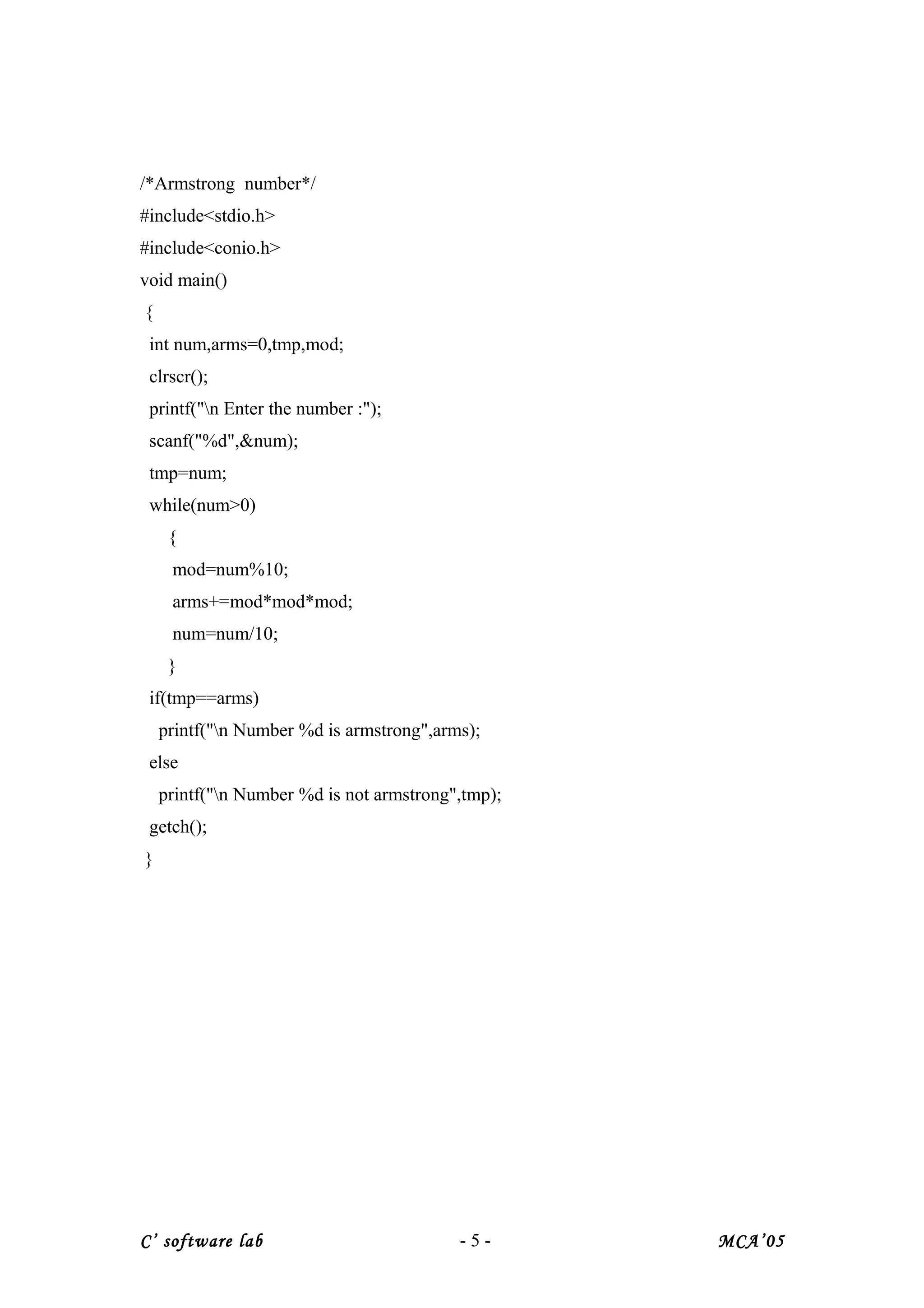
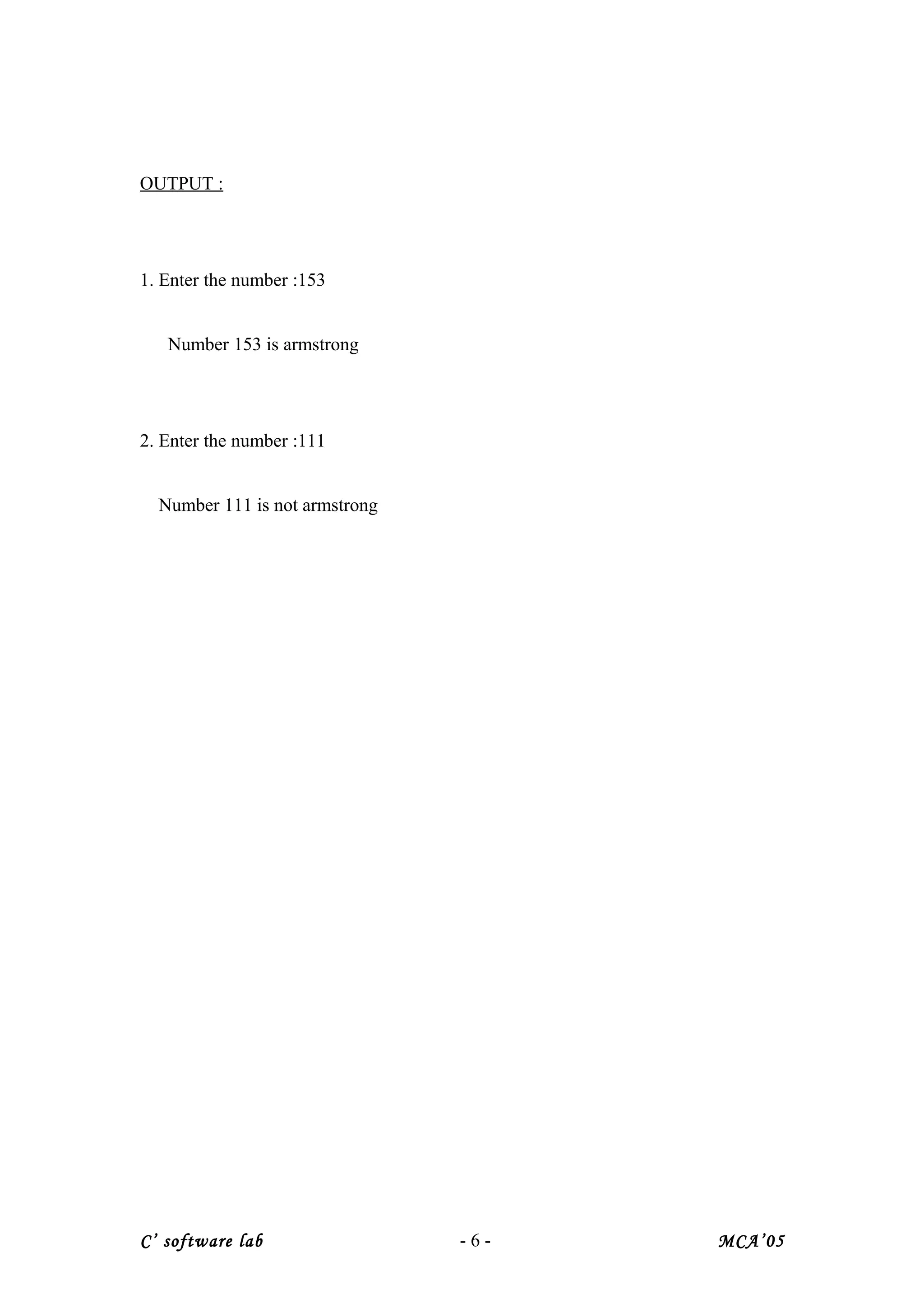
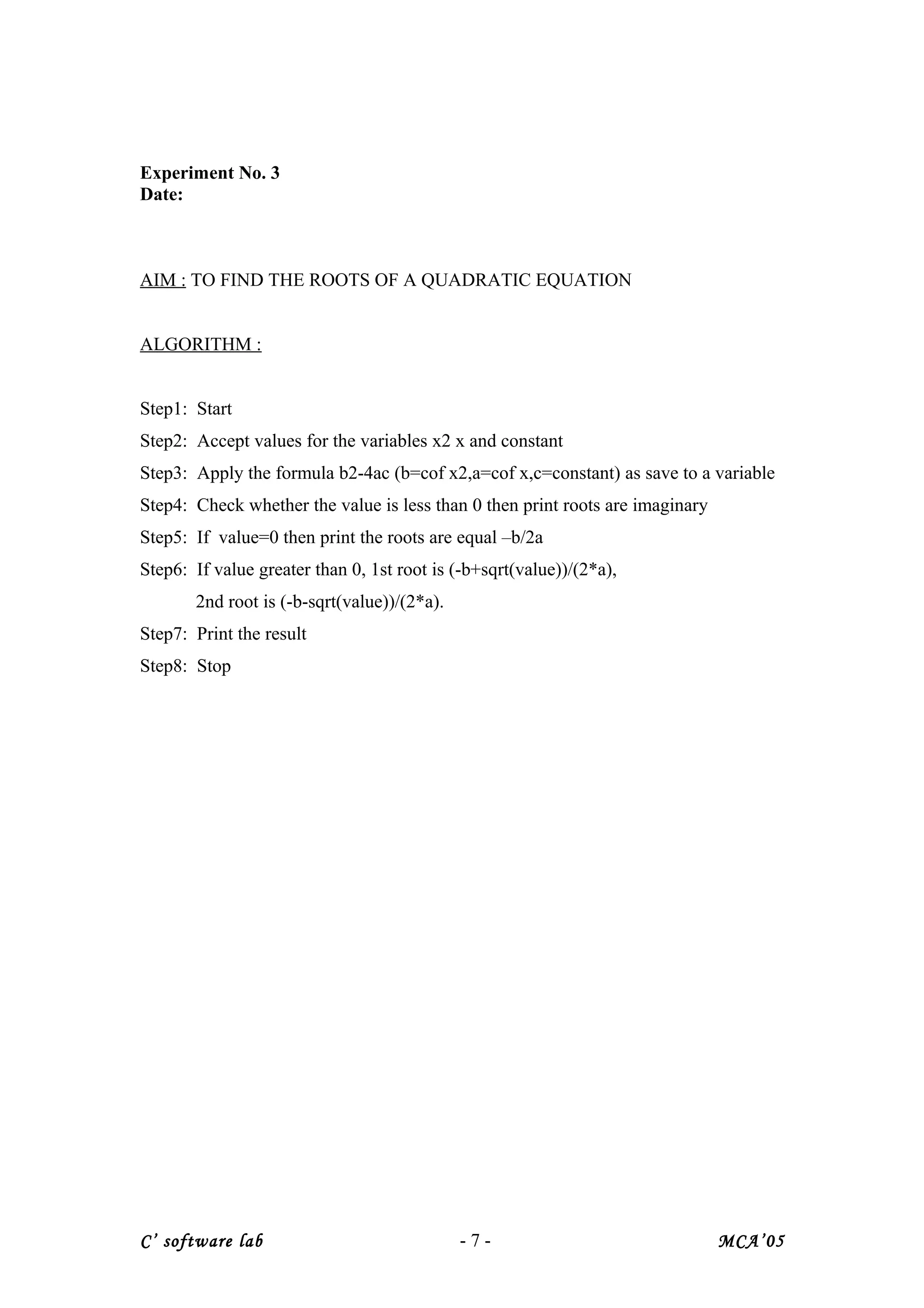
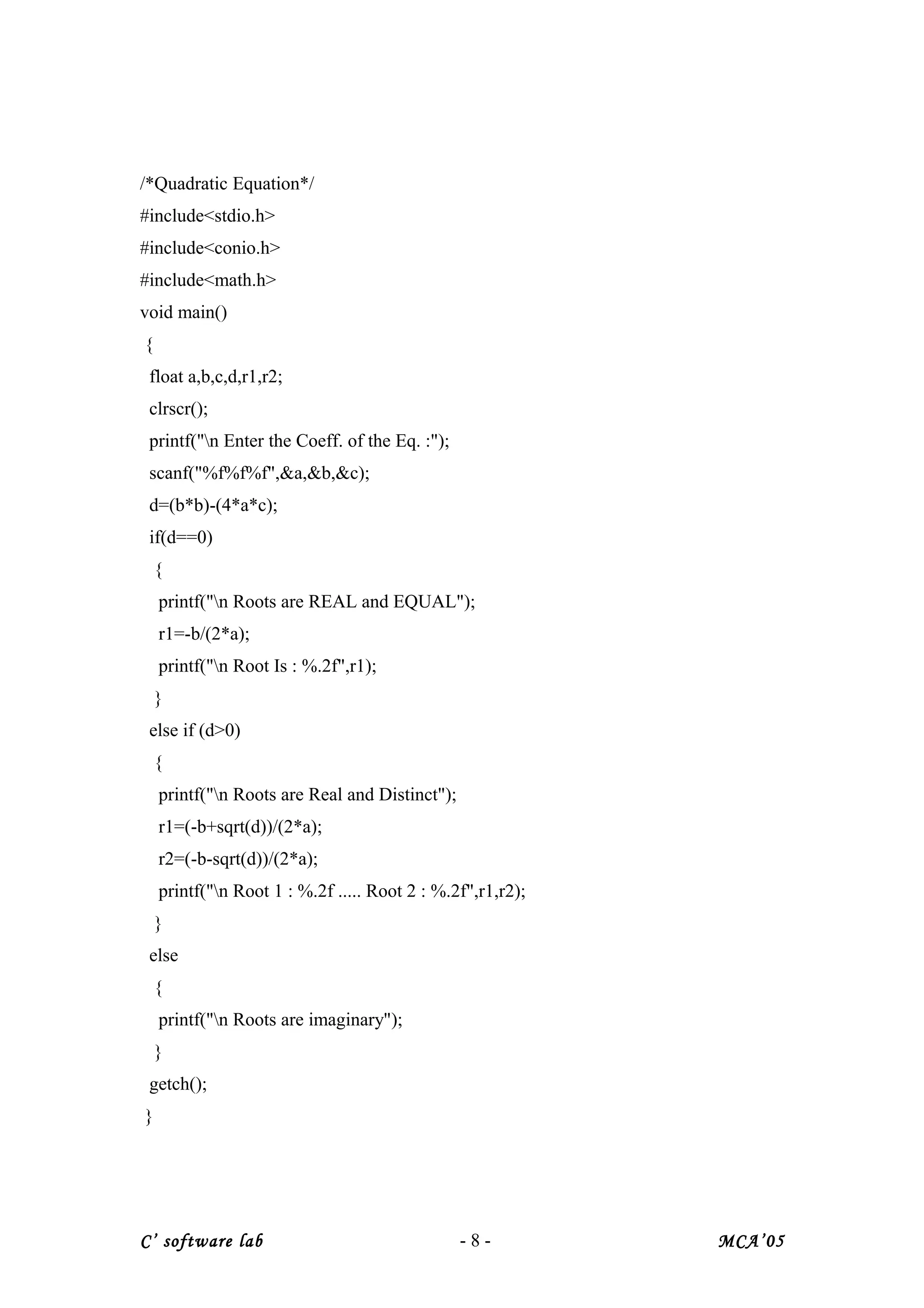
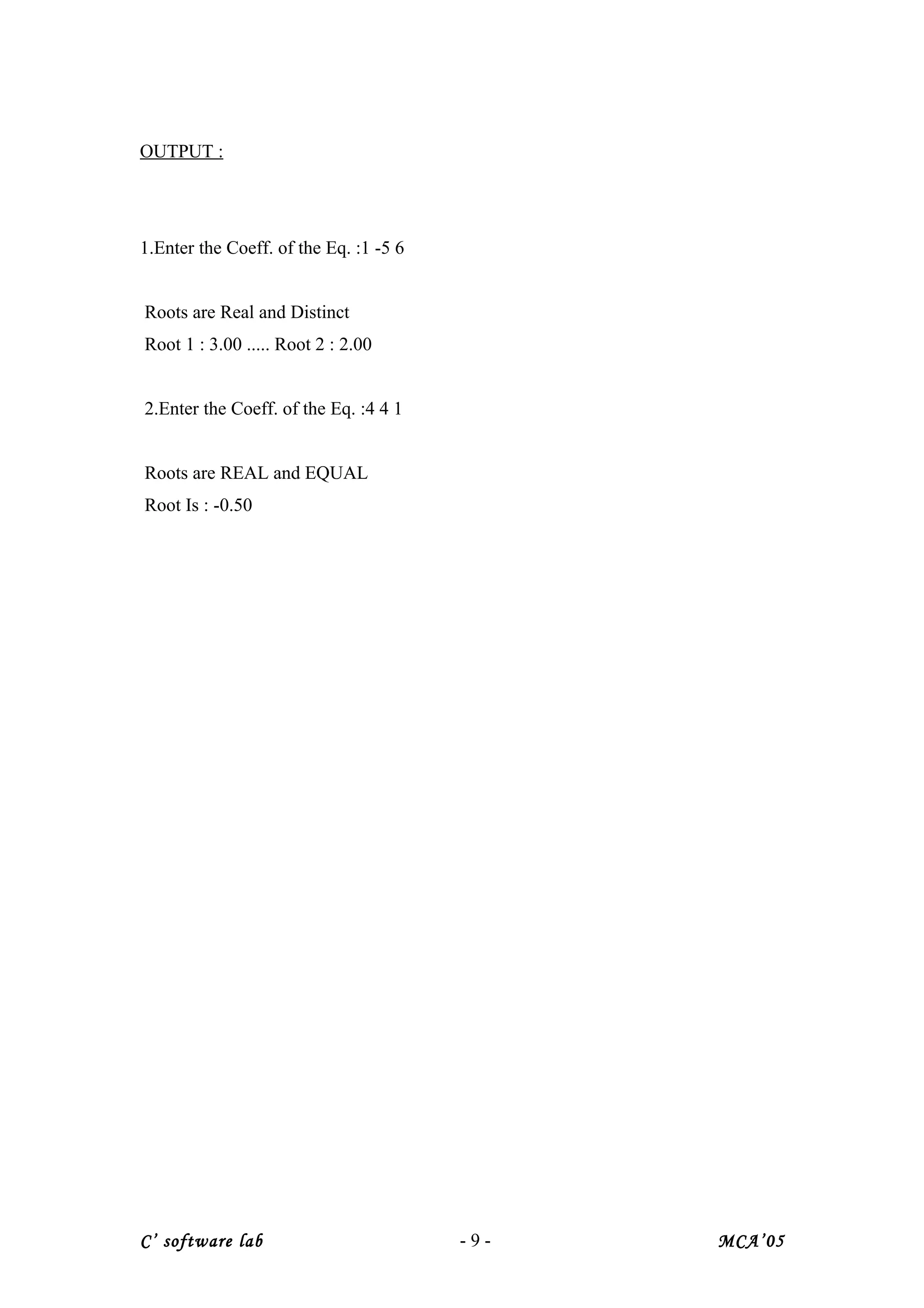
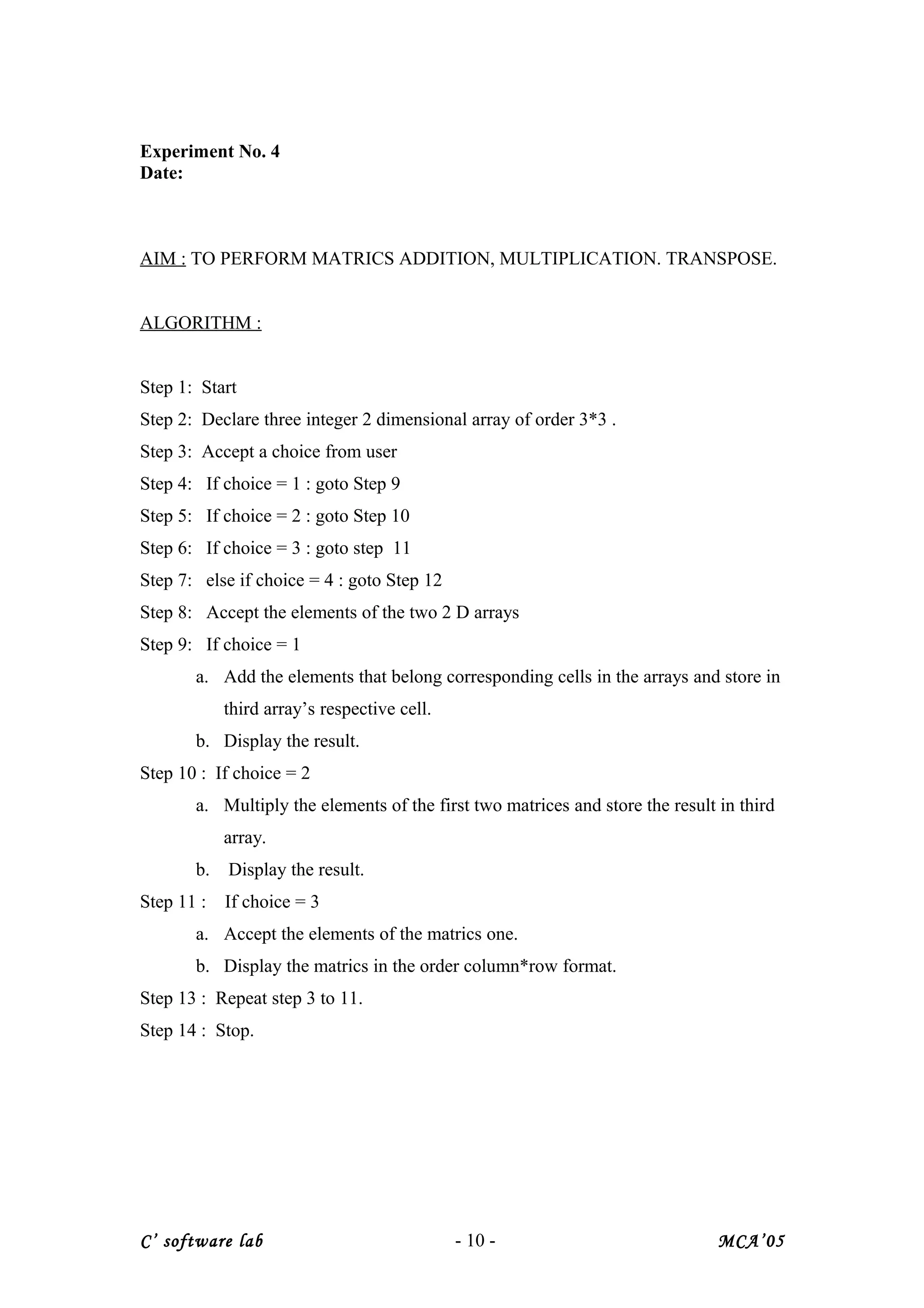
![/*Matrics Addition, Multiplication, Transpose*/
#include<stdio.h>
#include<conio.h>
int a[10][10],b[10][10],c[10][10],r1,r2,c1,c2,i,j,k,ch;
void add();
void mul();
void tran();
void accept(int [][10],int,int);
void display(int [][10],int,int);
void main()
{
clrscr();
do
{
clrscr();
printf("n Matrix Manipulator");
printf("n 1.Addition");
printf("n 2.Multiplication");
printf("n 3.Transpose");
printf("n press any other key to exit...");
printf("n Enter U'r choice :");
scanf("%d",&ch);
if (ch>=1&&ch<=3)
{
printf("n Enter order of the matrices :");
printf("n Mat 1 :");
scanf("%d%d",&r1,&c1);
printf("n Mat 2 :");
scanf("%d%d",&r2,&c2);
}
switch(ch)
{
C’ software lab - 11 - MCA’05](https://image.slidesharecdn.com/c-lab-programs-140703000544-phpapp02/75/C-lab-programs-11-2048.jpg)
![case 1:
if((r1==r2)&&(c1==c2))
add();
else
printf("n addition not possible...");
getch();
break;
case 2:
if(c1==r2)
mul();
else
printf("n multiplication not possible...");
getch();
break;
case 3: tran();getch();break;
default: printf("n Wrong choice Exit...");
}
}while(ch>0&&ch<4);
getch();
}
void add()
{
printf("n Matrics addition");
printf("n Enter Matrics 1:");
accept(a,r1,c1);
printf("n Enter Matrics 2:");
accept(b,r2,c2);
for(i=0;i<r1;i++)
for(j=0;j<c1;j++)
c[i][j]= a[i][j]+b[i][j];
printf("n Matrics A :n");
C’ software lab - 12 - MCA’05](https://image.slidesharecdn.com/c-lab-programs-140703000544-phpapp02/75/C-lab-programs-12-2048.jpg)
![display(a,r1,c1);
printf("n Matrics B :n");
display(b,r2,c2);
printf("n Matrics C :n");
display(c,r1,c2);
}
void mul()
{
printf("n Matrics multiplication");
printf("n Enter Matrics 1:");
accept(a,r1,c1);
printf("n Enter Matrics 2:");
accept(b,r2,c2);
for(i=0;i<r1;i++)
for(j=0;j<c2;j++)
{
c[i][j]=0;
for(k=0;k<c1;k++)
c[i][j] += a[i][k]*b[k][j];
}
printf("n Matrics A :n");
display(a,r1,c1);
printf("n Matrics B :n");
display(b,r2,c2);
printf("n Matrics C :n");
display(c,r1,c2);
}
void tran()
{
printf("n Matrics Transpose");
C’ software lab - 13 - MCA’05](https://image.slidesharecdn.com/c-lab-programs-140703000544-phpapp02/75/C-lab-programs-13-2048.jpg)
![printf("n Enter Matrics :n");
accept(a,r1,c1);
display(a,r1,c1);
printf("n Transposed Matrics :n");
for(i=0;i<r1;i++)
{
for(j=0;j<c1;j++)
{
printf("%dt",a[j][i]);
}
printf("n");
}
}
void display(int x[][10],int m,int n)
{
for(i=0;i<m;i++)
{
for(j=0;j<n;j++)
{
printf("%dt",x[i][j]);
}
printf("n");
}
}
void accept(int x[][10],int m,int n)
{
for(i=0;i<m;i++)
{
for(j=0;j<n;j++)
{
C’ software lab - 14 - MCA’05](https://image.slidesharecdn.com/c-lab-programs-140703000544-phpapp02/75/C-lab-programs-14-2048.jpg)
![scanf("%d",&x[i][j]);
}
}
}
C’ software lab - 15 - MCA’05](https://image.slidesharecdn.com/c-lab-programs-140703000544-phpapp02/75/C-lab-programs-15-2048.jpg)
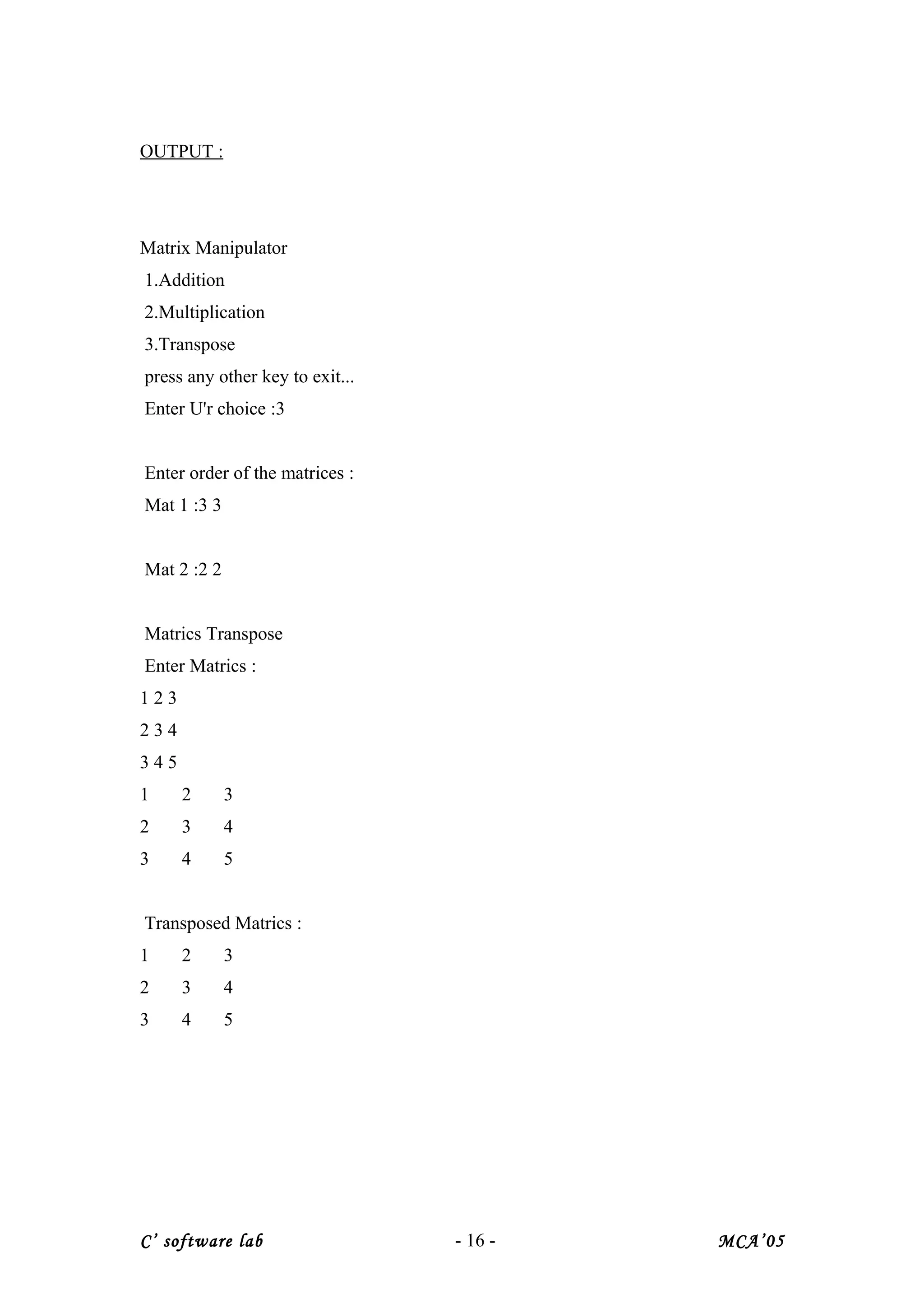
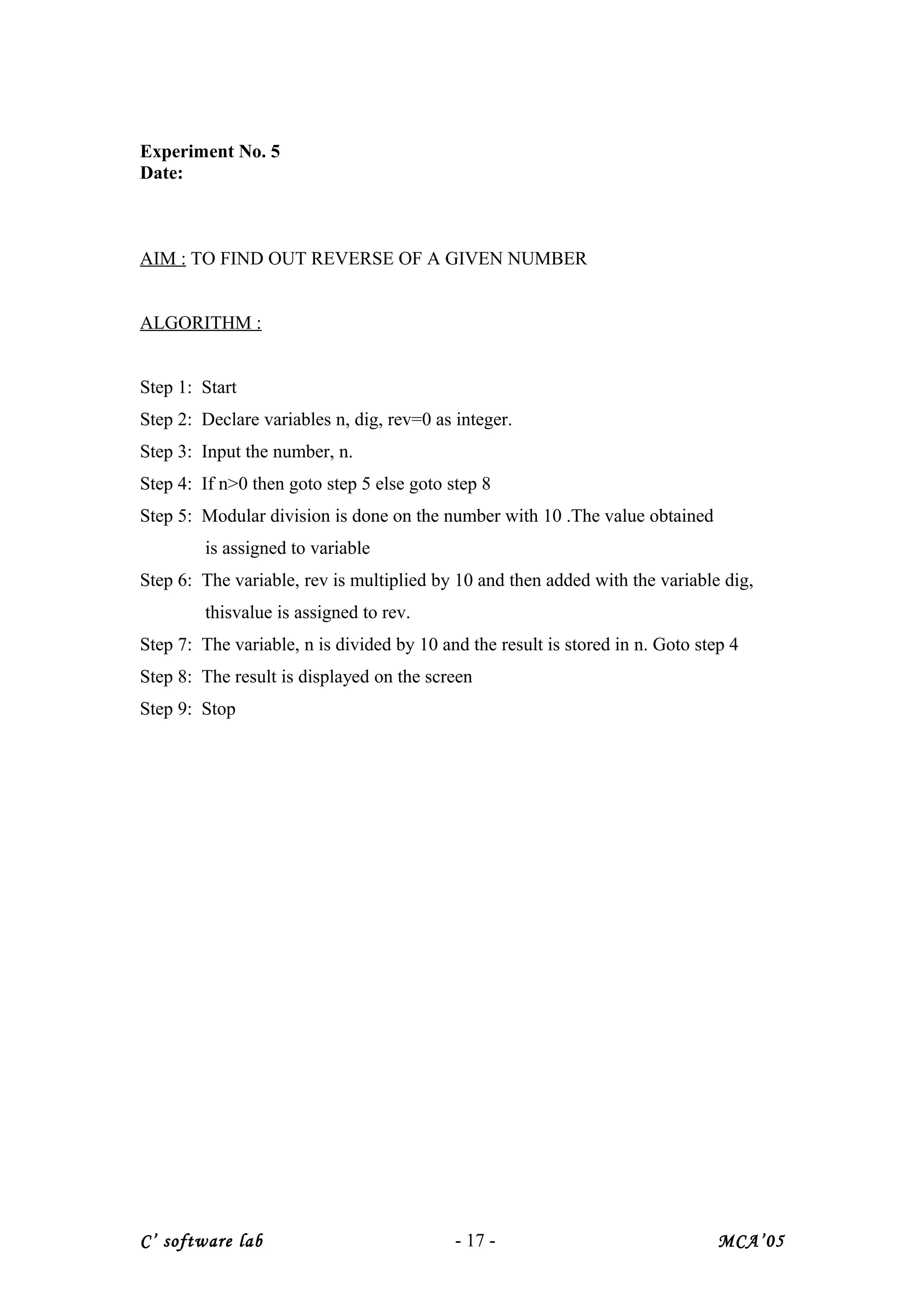
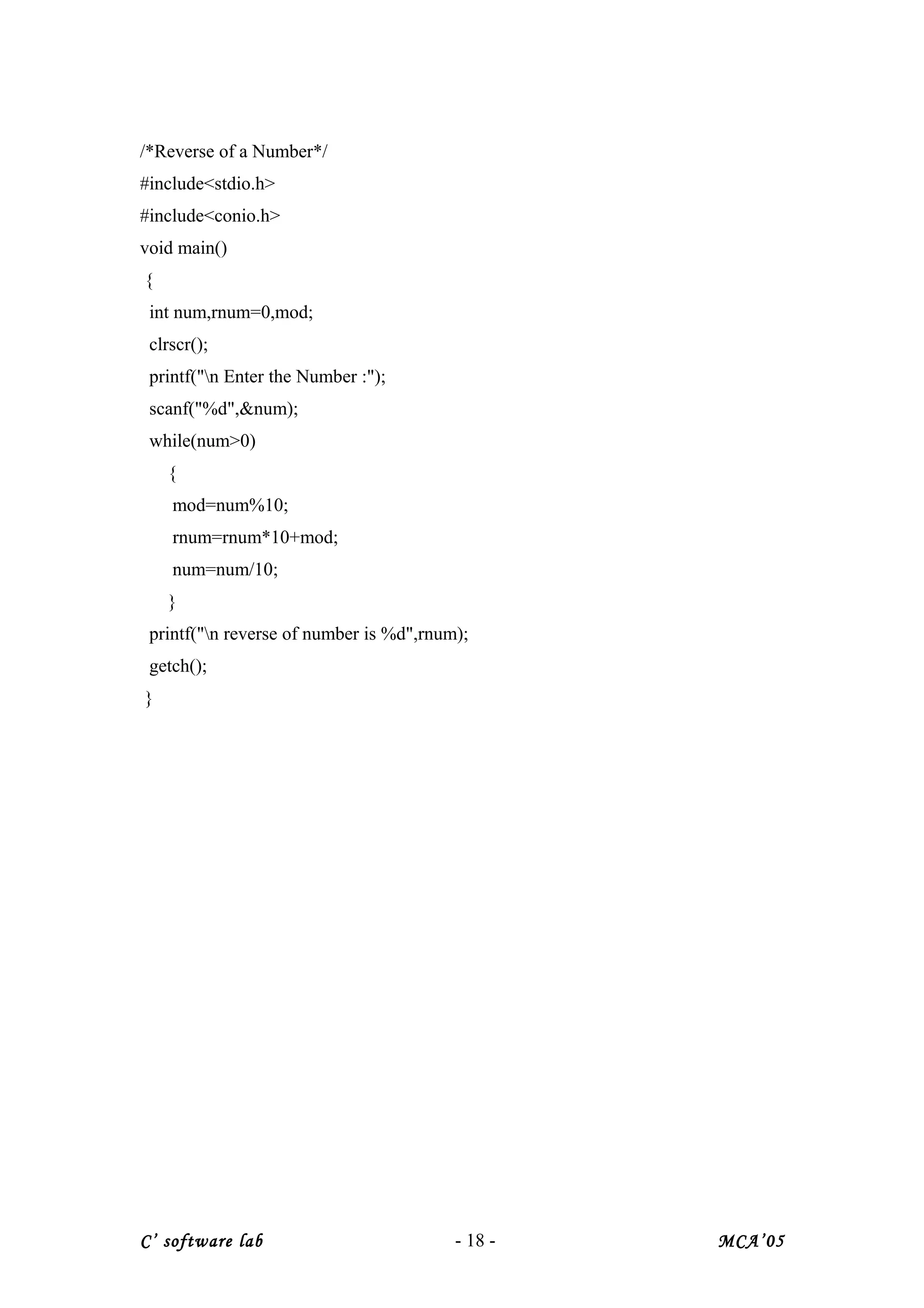
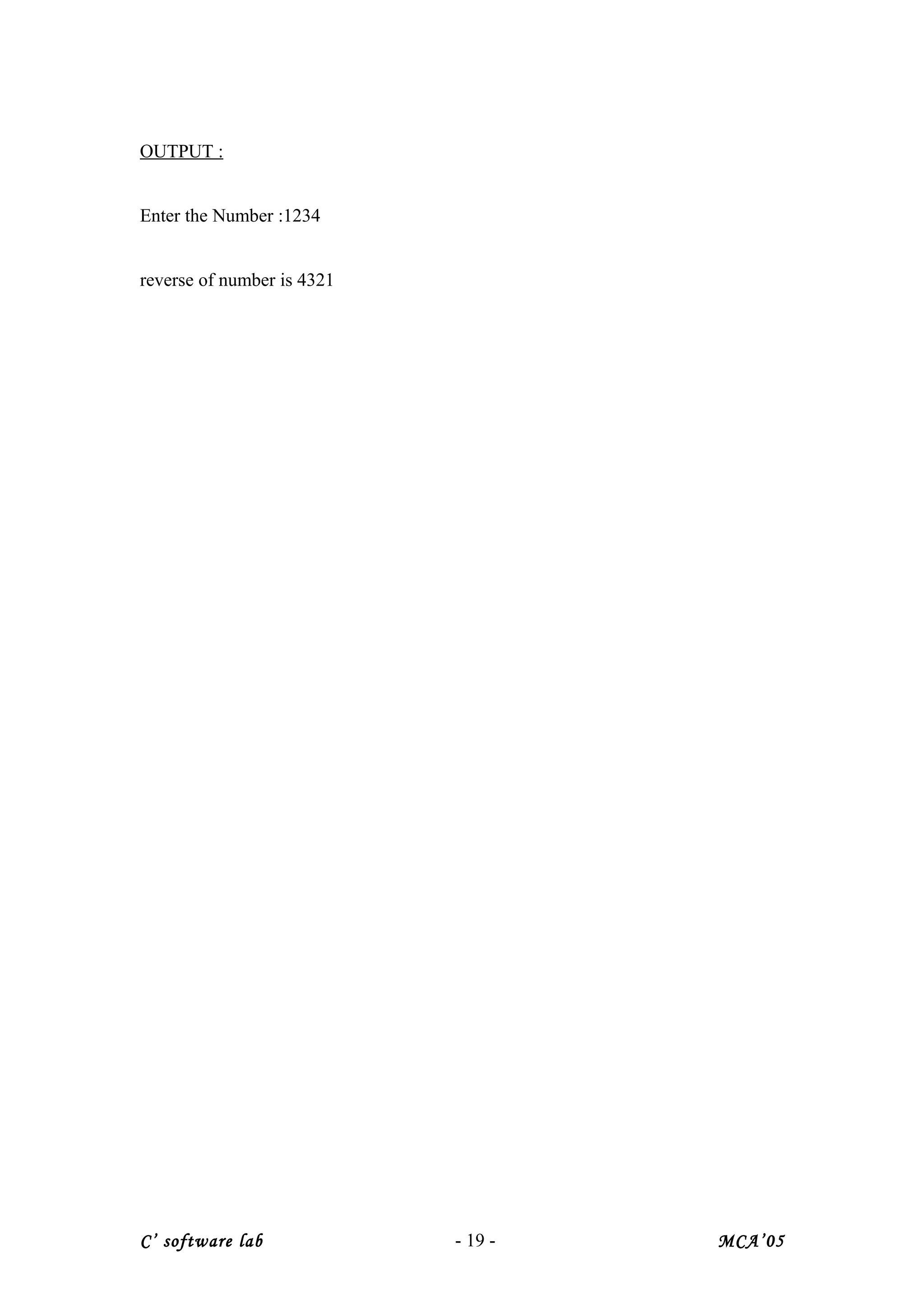
![Experiment No. 6
Date:
AIM : PERFORM SORTING A ONE DIMENSIONAL
ALGORITHM :
Step 1 : Start
Step 2 : Read the limit, N
Step 3 : Read elements of A[N] using for loop
Step 4 : Using for loop check whether A[I]>A[J] if yes then proceed
Step 5 : tA[I]
Step 6 : A[I]A[J]
Step 7 : A[J]t
Step 8 : End If
Step 9 : End for
Step 10 : Print Sorted array A[N]
Step 11 : Stop
C’ software lab - 20 - MCA’05](https://image.slidesharecdn.com/c-lab-programs-140703000544-phpapp02/75/C-lab-programs-20-2048.jpg)
![/*Sorting a 1-D array*/
#include<stdio.h>
#include<conio.h>
void main()
{
int a[15],i,tmp,j,k;
clrscr();
printf("n Enter the Size :");
scanf("%i",&i);
printf("n Enter the elements in the array : n");
for(j=0;j<i;j++)
{
scanf("%d",&a[j]);
}
printf("n Entered Elements are : n");
for(j=0;j<i;j++)
{
printf("%dt",a[j]);
}
for(j=0;j<i;j++)
{
for(k=j;k<i;k++)
{
if(a[j]>a[k])
{
tmp = a[j];
a[j]= a[k];
a[k]=tmp;
}
}
}
printf("n Sorted Elements are : n");
C’ software lab - 21 - MCA’05](https://image.slidesharecdn.com/c-lab-programs-140703000544-phpapp02/75/C-lab-programs-21-2048.jpg)
![for(j=0;j<i;j++)
{
printf("%dt",a[j]);
}
getch();
}
C’ software lab - 22 - MCA’05](https://image.slidesharecdn.com/c-lab-programs-140703000544-phpapp02/75/C-lab-programs-22-2048.jpg)
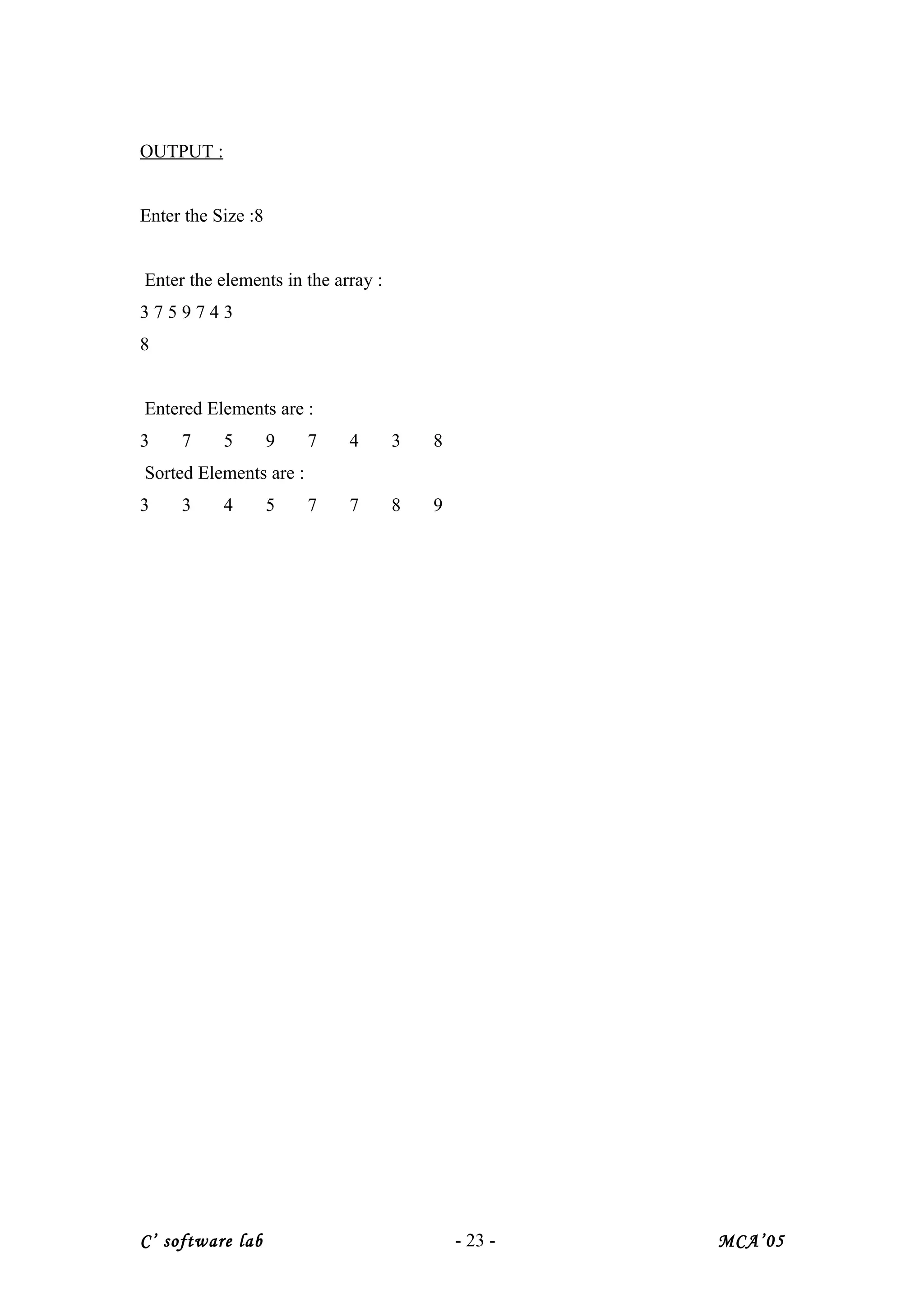

![/*Deleting Duplicates in a 1-D array*/
#include<stdio.h>
#include<conio.h>
void main()
{
int a[15],i,tmp,j,k;
clrscr();
printf("n Enter the Size :");
scanf("%i",&i);
printf("n Enter the elements in the array : n");
for(j=0;j<i;j++)
{
scanf("%d",&a[j]);
}
printf("n Entered Elements are : n");
for(j=0;j<i;j++)
{
printf("%dt",a[j]);
}
for(j=0;j<i;j++)
{
for(k=j;k<i;k++)
{
if(a[j]>a[k])
{
tmp = a[j];
a[j]= a[k];
a[k]=tmp;
}
}
}
for(j=0;j<i;j++)
C’ software lab - 25 - MCA’05](https://image.slidesharecdn.com/c-lab-programs-140703000544-phpapp02/75/C-lab-programs-25-2048.jpg)
![{
if(a[j]==a[j+1])
{
for(k=j;k<i;k++)
{
a[k]=a[k+1];
}
i--;j--;
}
}
printf("n Sorted Elements are : n");
for(j=0;j<i;j++)
{
printf("%dt",a[j]);
}
getch();
}
C’ software lab - 26 - MCA’05](https://image.slidesharecdn.com/c-lab-programs-140703000544-phpapp02/75/C-lab-programs-26-2048.jpg)
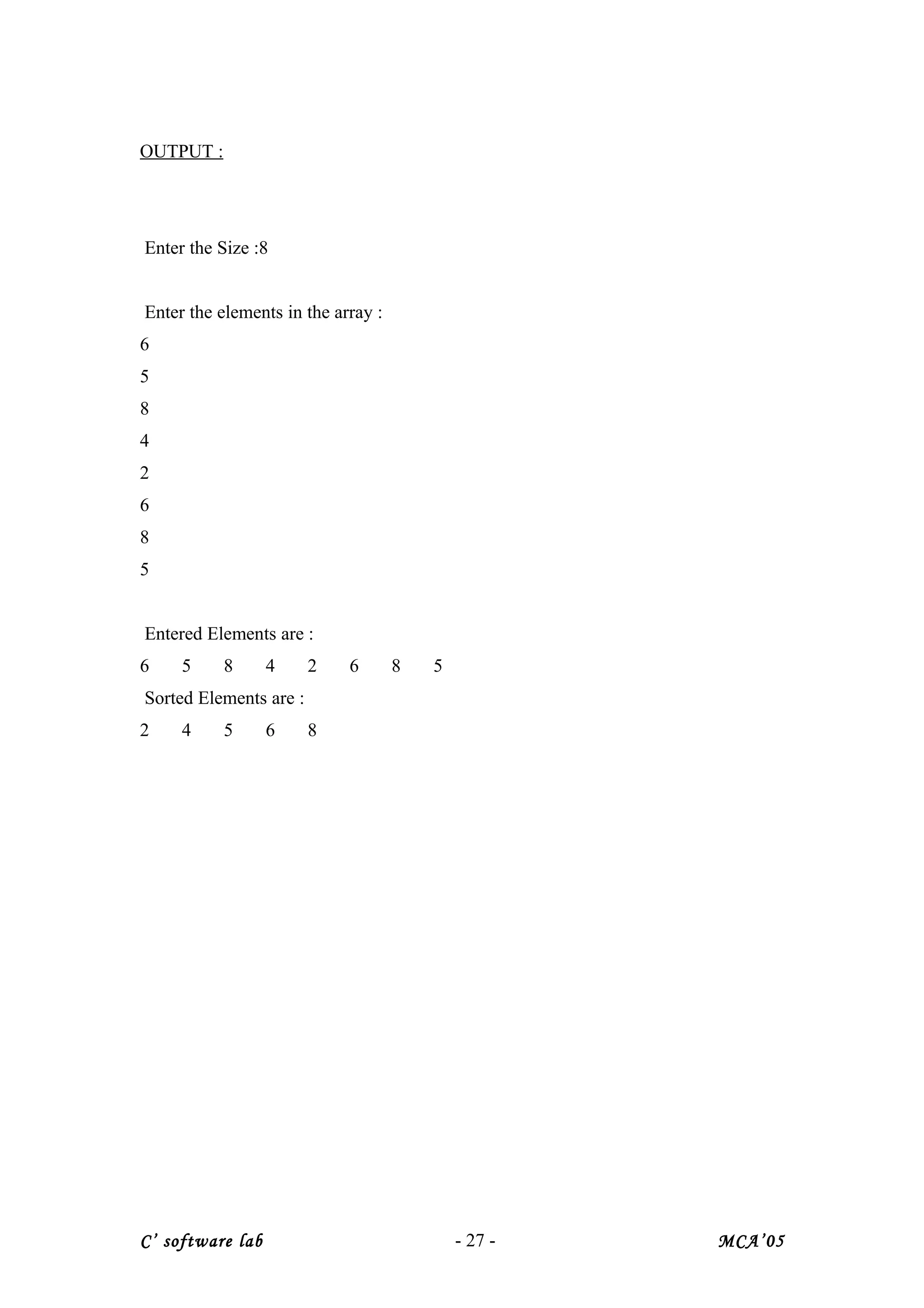


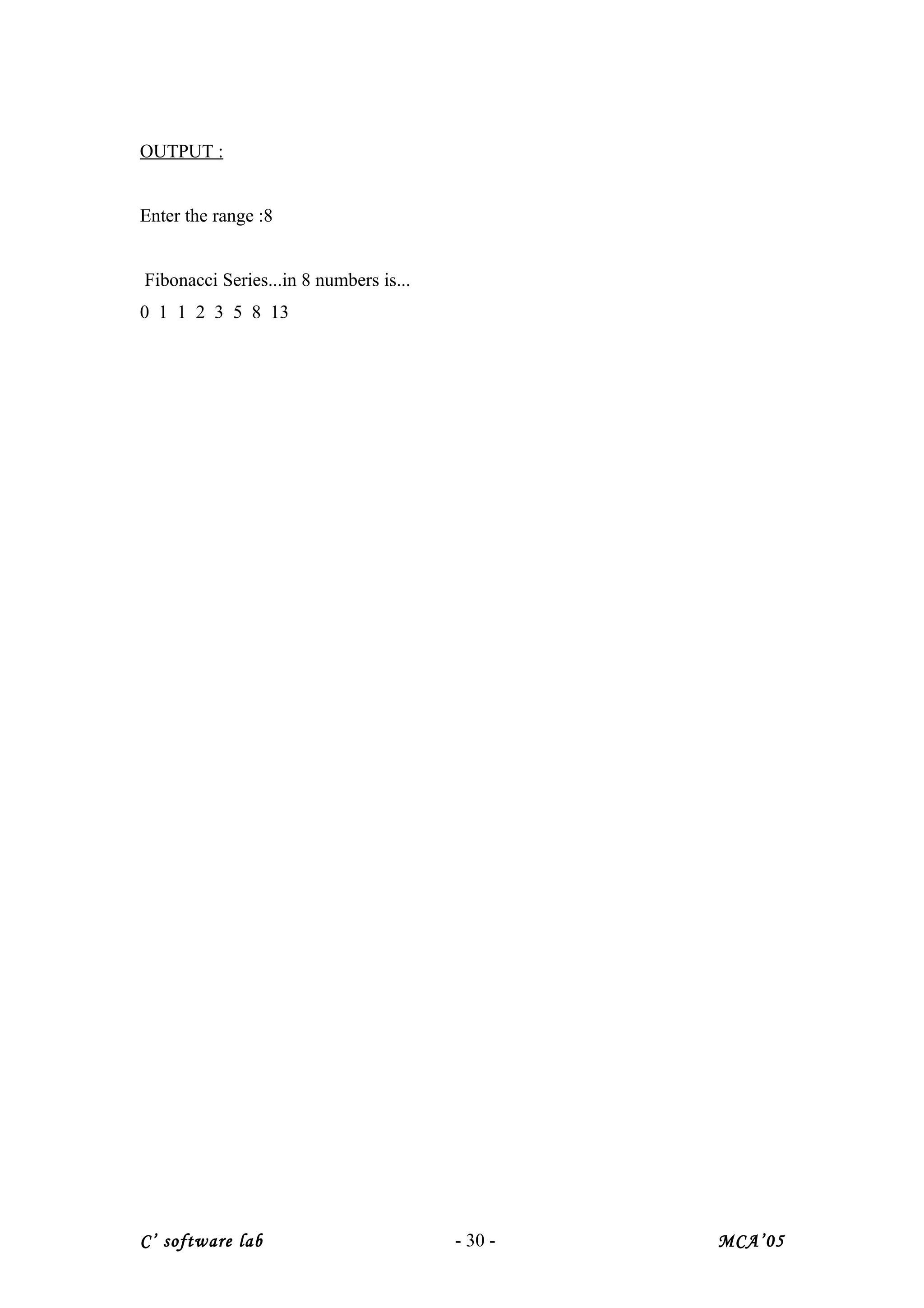
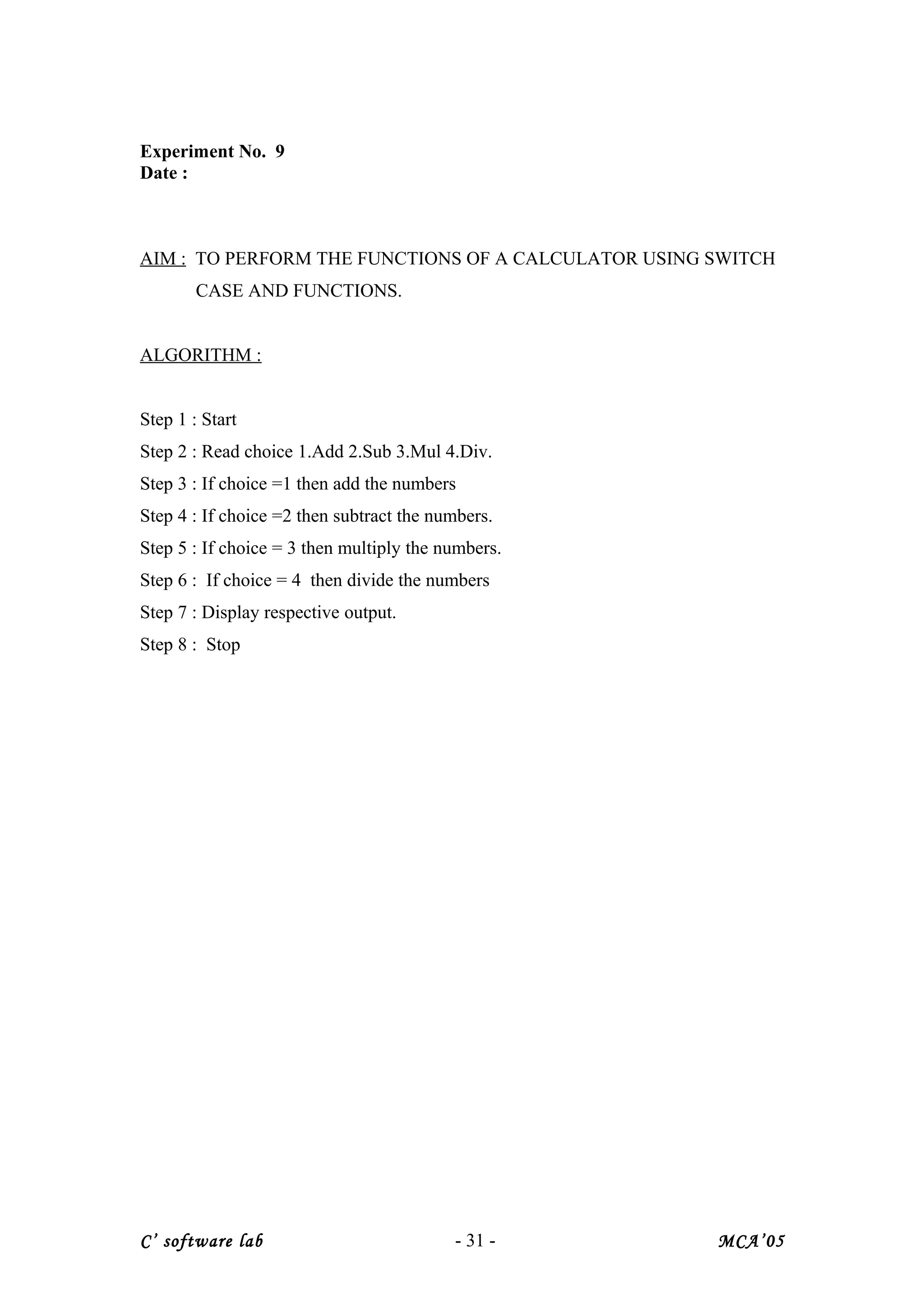
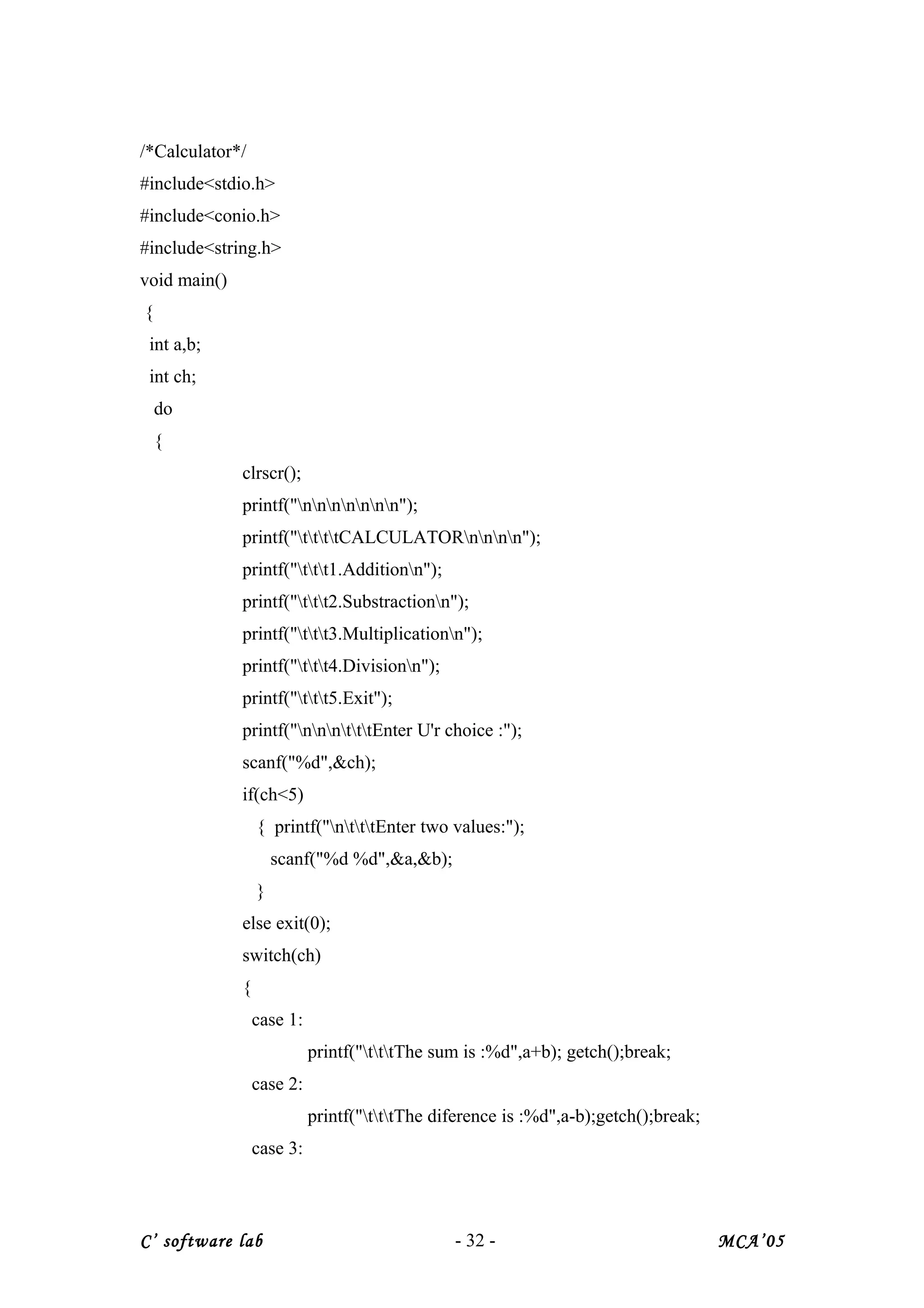

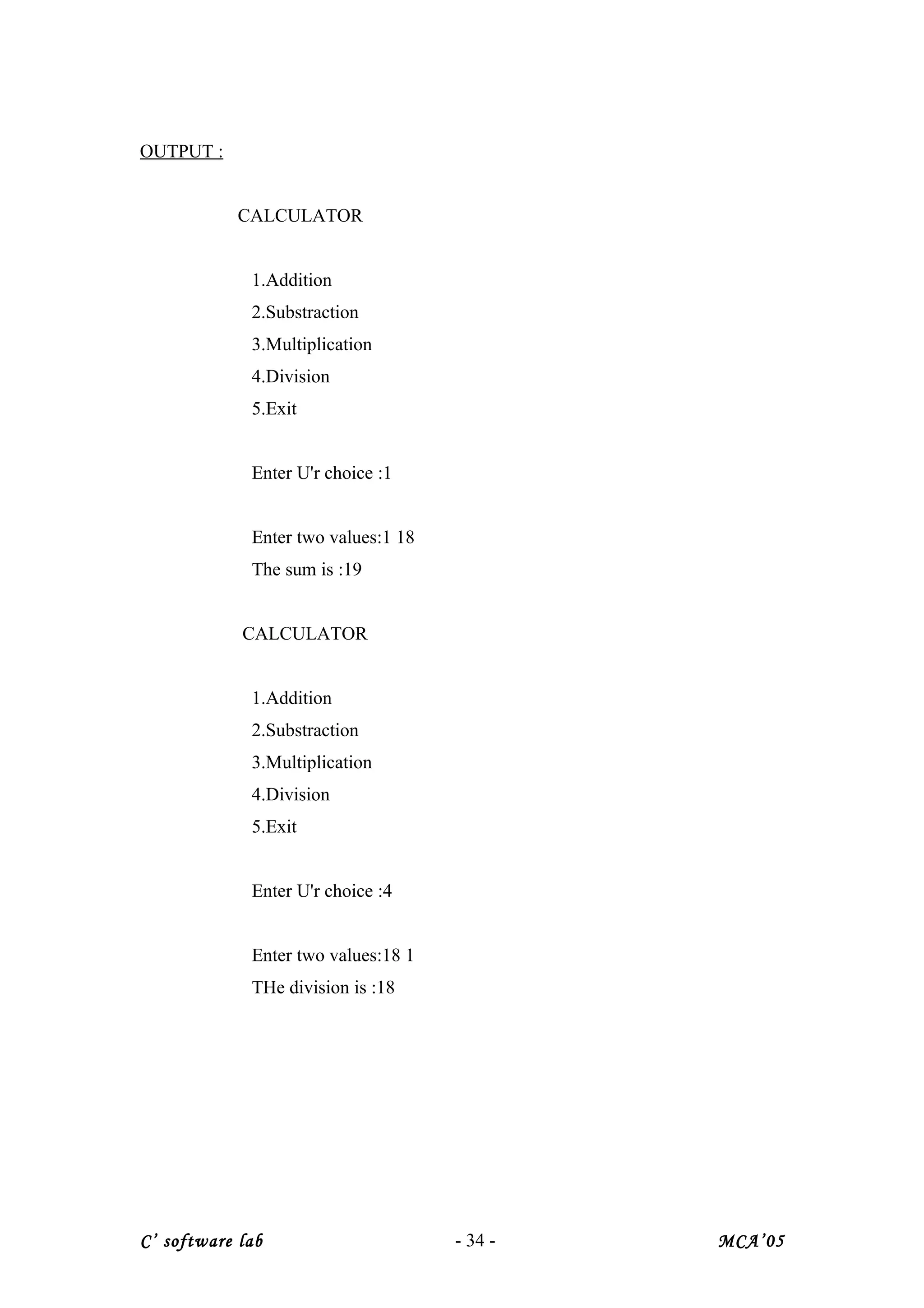
![Experiment No.10
Date:
AIM : TO WRITE A PROGRAM TO CREATE AND MANIPULATE STUDENTS
RECORD USING STRUCTURES AND POINTERS.
ALGORITHM :
Step 1 : Start
Step 2 : Declare structure Stud
Roll_no as Integer
Name as Character array
Grade as Character
Mark, as an integer array
Step 3 : Create student object as an array as st[10], and also a pointer object *sd
Step 4 : Declare tot_mark, n
Step 5 : Accept number of entries as n
Step 6 : Accept student details
Step 7 : Calculate the average of students as sum of marks / 3
Step 8 : Calculate the grades and store to structure as on the conditions
if average > = 80 : grade = A
if average > = 60 and average < 80 : grade = B
if average > = 50 and average < 60 : grade = c
else if average < 50 : grade = Failed
Step 9 : Print details of students as per fields in the structure
Step 10 : Stop
C’ software lab - 35 - MCA’05](https://image.slidesharecdn.com/c-lab-programs-140703000544-phpapp02/75/C-lab-programs-35-2048.jpg)
![/*Student’s Record Using Poinetrs*/
#include<stdio.h>
#include<conio.h>
struct stud
{
int regno;
char name[20];
int mark[3];
char grade;
}s[10],*st;
void main()
{
int i,avg=0,j,num;
clrscr();
printf("n Enter the number of students...");
scanf("%d",&num);
st = s;
for(i=0;i<num;i++)
{
printf("n Enter student's Details :");
printf("n Roll no :");
scanf("%d",&st->regno);
printf(" Name :");
scanf("%s",st->name);
for(j=0;j<3;j++)
{
printf(" mark %d :",j+1);
scanf("%d",&st->mark[j]);
avg+=st->mark[j];
}
printf("Average of %s is %d",st->name,avg=avg/3);
C’ software lab - 36 - MCA’05](https://image.slidesharecdn.com/c-lab-programs-140703000544-phpapp02/75/C-lab-programs-36-2048.jpg)
![if(avg>=80)
st->grade='A';
else if(avg>=60 && avg<80)
st->grade='B';
else if(avg>=50 && avg<60)
st->grade='C';
else
st->grade='F';
st++;
avg=0;
}
st=s;
printf("n Student details...");
printf("nReg_notNamettMarkst1t2t3tgrade");
for(i=0;i<num;i++)
{
printf("n%dt%sttt%dt%dt%dt%c",st->regno,st->name,st->mark[0],st-
>mark[1],st->mark[2],st->grade);
st++;
}
getch();
}
C’ software lab - 37 - MCA’05](https://image.slidesharecdn.com/c-lab-programs-140703000544-phpapp02/75/C-lab-programs-37-2048.jpg)
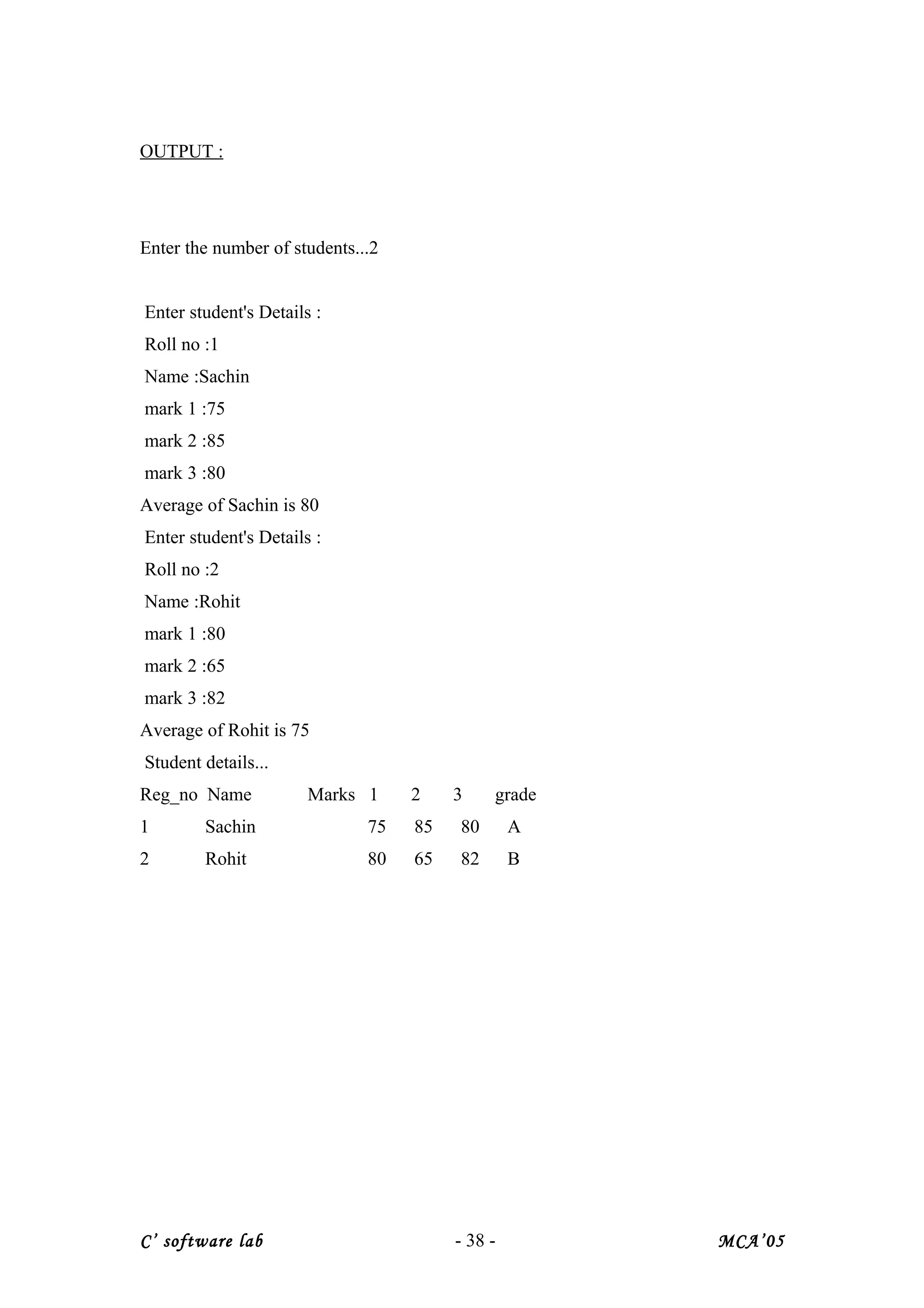
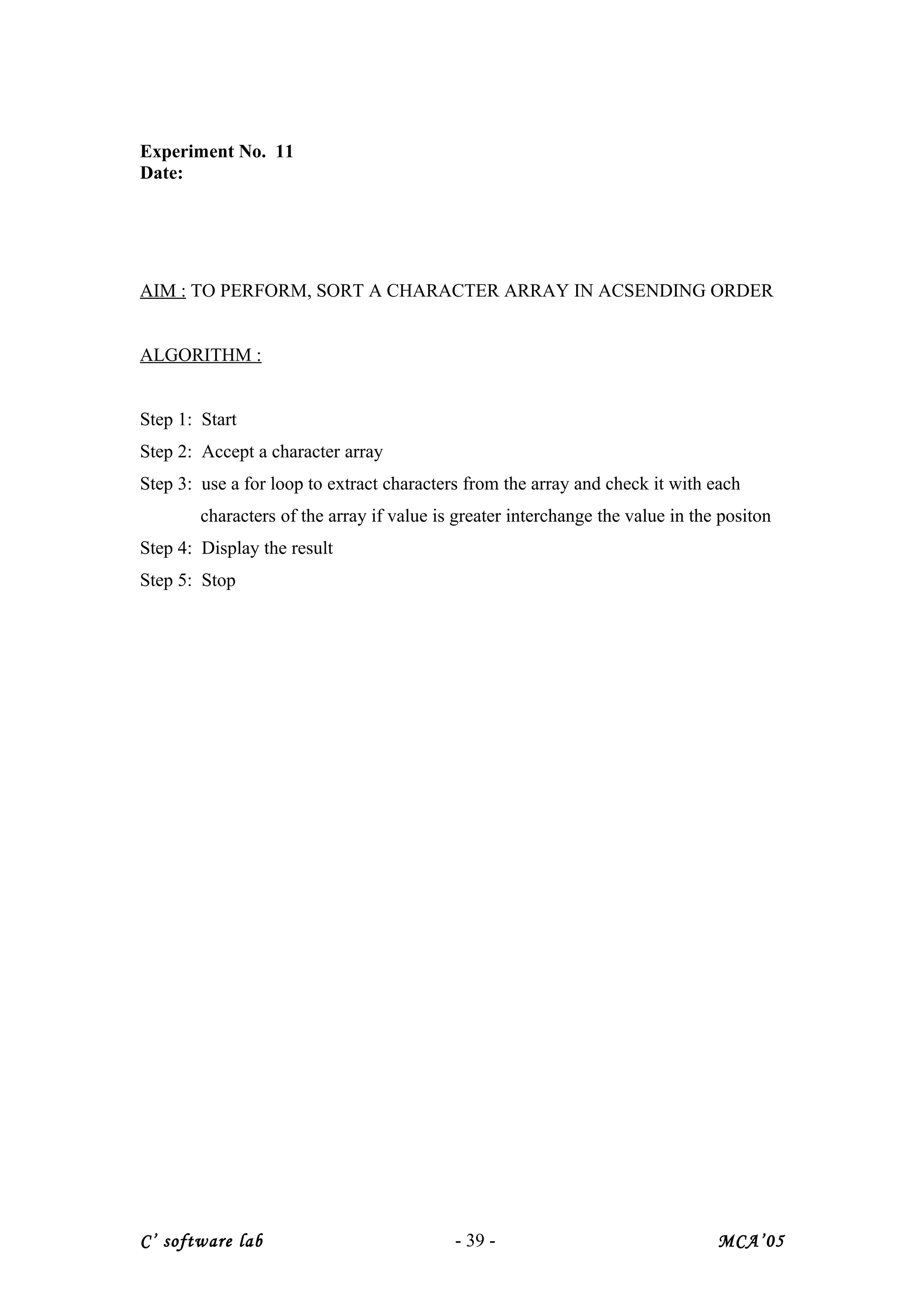
![/*Sorting a 1-D Charater array*/
#include<stdio.h>
#include<conio.h>
void main()
{
char str[20],tmp;
int len,i,j;
clrscr();
printf("n Enter the Char. array...");
scanf("%s",str);
for(len=0;str[len]!='0';len++);
printf("n Entered Char.array is...%s",str);
printf("n Length of entered string is...%dn",len);
for(i=0;i<len;i++)
for(j=i;j<len;j++)
if(str[i]<str[j])
{
tmp=str[i];
str[i]=str[j];
str[j]=tmp;
}
printf("n Sorted Char.array is...%s",str);
getch();
}
C’ software lab - 40 - MCA’05](https://image.slidesharecdn.com/c-lab-programs-140703000544-phpapp02/75/C-lab-programs-40-2048.jpg)
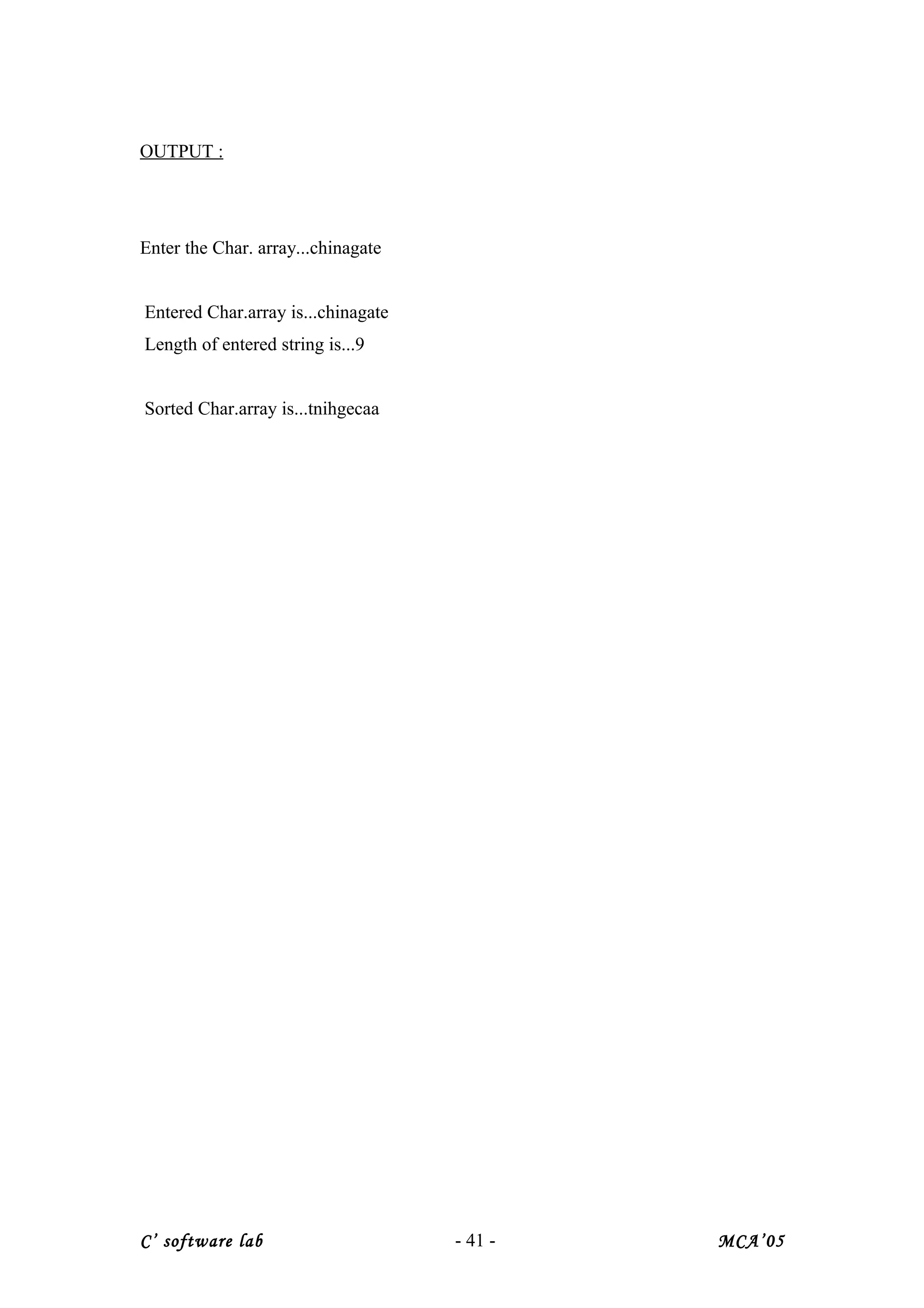
![Experiment No. 12
Date:
AIM : TO PROGRAM TO CHECK THE OCCURRENCE OF A PARTICULAR
NUMBER IN AN ARRAY.
ALGORITHM :
Step 1: Start
Step 2: Declare array a[25], variables n,i,num,count=0 as integer.
Step 3: Store the limit of the array in the variable n.
Step 4: Store the values of the array.
Step 5: Enter the value to be checked and store it in the variable, num.
Step 6: Start a for loop with loop variable, i.Compare each element of the array with
variable num. For each a[i]=num increment the counter count by 1.
Step 7: Display count on the output screen as the number of occurrence.
Step 8: Stop.
C’ software lab - 42 - MCA’05](https://image.slidesharecdn.com/c-lab-programs-140703000544-phpapp02/75/C-lab-programs-42-2048.jpg)
![/*occurance of particular number in an array*/
#include<stdio.h>
#include<conio.h>
void main()
{
int i,j,a[25],n,num,count=0,temp,flag=0,ch;
clrscr();
do
{
clrscr();
printf("nnEnter number of elements:");
scanf("%d",&n);
printf("nEnter %d array elements:n",n);
for(j=0;j<n;j++)
scanf("%d",&a[j]);
printf("nEnter the number to be searched:");
scanf("%d",&num);
printf("nThe positions of the given number are: ");
for(i=0;i<n;i++)
{
if(a[i]==num)
{
printf("%5d",i+1);
count++; flag=1;
}
}
if(flag==1)
{
printf("nn%d is repeated %d times in the array",num,count);
count = 0;
flag = 0;
}
C’ software lab - 43 - MCA’05](https://image.slidesharecdn.com/c-lab-programs-140703000544-phpapp02/75/C-lab-programs-43-2048.jpg)
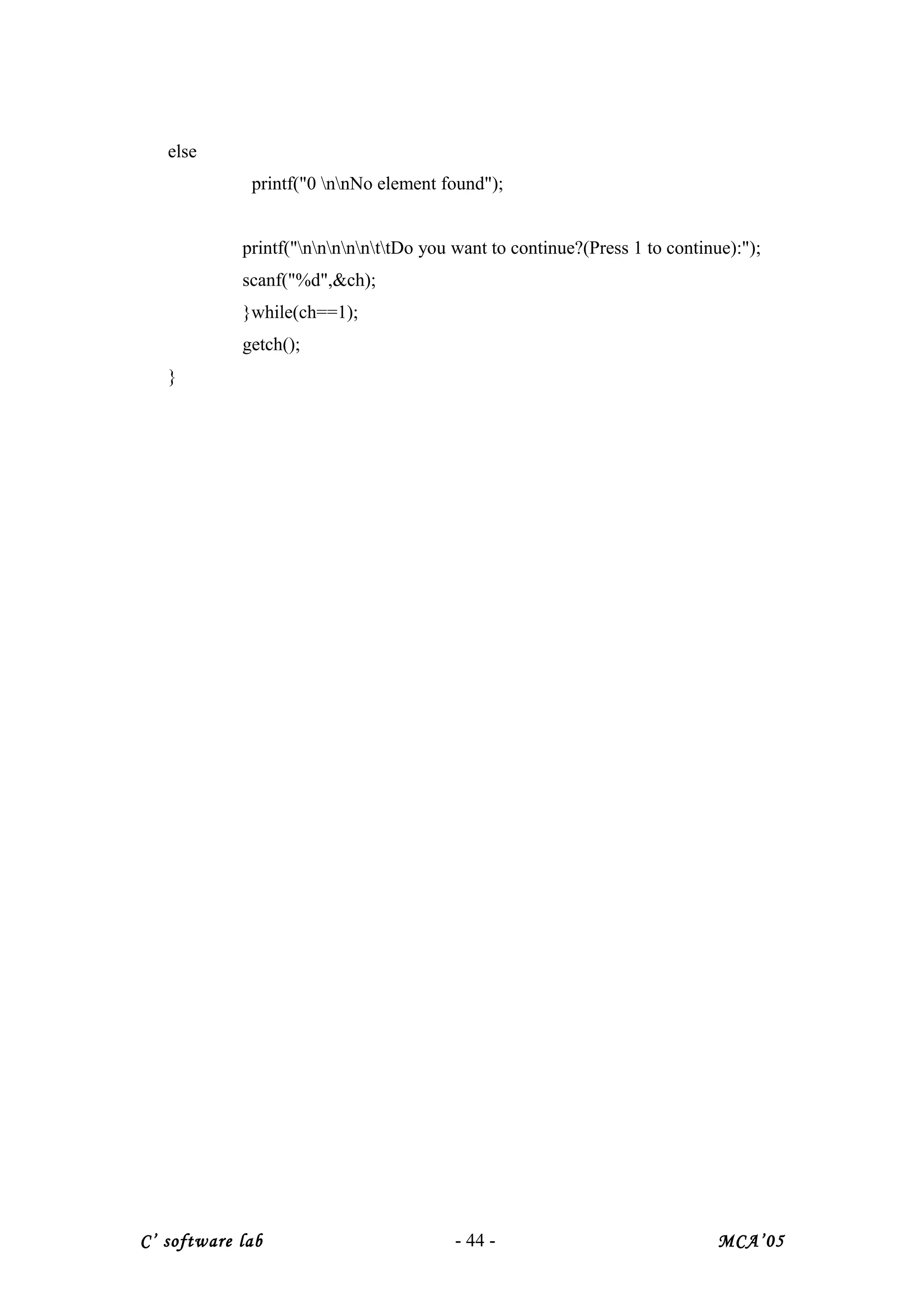

![Experiment No. 13
Date:
AIM : TO CHECK WHETHER A GIVEN STRING IS PALINDROME OR NOT
ALGORITHM :
Step 1: Start
Step 2: Initialize a string array a[100],flag=0
Step 3: Calculate length of the string using strlen() function
Step 4: Using for loop from I=0,J=len-1 to j<len/2 perform step 5
Step 5: Check whether A[I] != A[J] if false Set flag=1
Step 6: End for
Step 7: If flag=0 print Palindrome else Not Palindrome
Step 8: Stop
C’ software lab - 46 - MCA’05](https://image.slidesharecdn.com/c-lab-programs-140703000544-phpapp02/75/C-lab-programs-46-2048.jpg)
![/*palindrome*/
#include<stdio.h>
#include<conio.h>
#include<string.h>
void main()
{
char str[10],str1[10];
int i,n,j;
clrscr();
printf("Enter a string:");
scanf("%s",str);
n=strlen(str);
for(i=0,j=n-1;i<n/2;i++,j--)
str[i]=tolower(str[i]);
str[j]=tolower(str[j]);
if(str[i]!=str[j])
{
printf("n String is Not a palindrome") ;
getch();
exit(0);
}
printf("n String is a Palindrome");
getch();
}
C’ software lab - 47 - MCA’05](https://image.slidesharecdn.com/c-lab-programs-140703000544-phpapp02/75/C-lab-programs-47-2048.jpg)
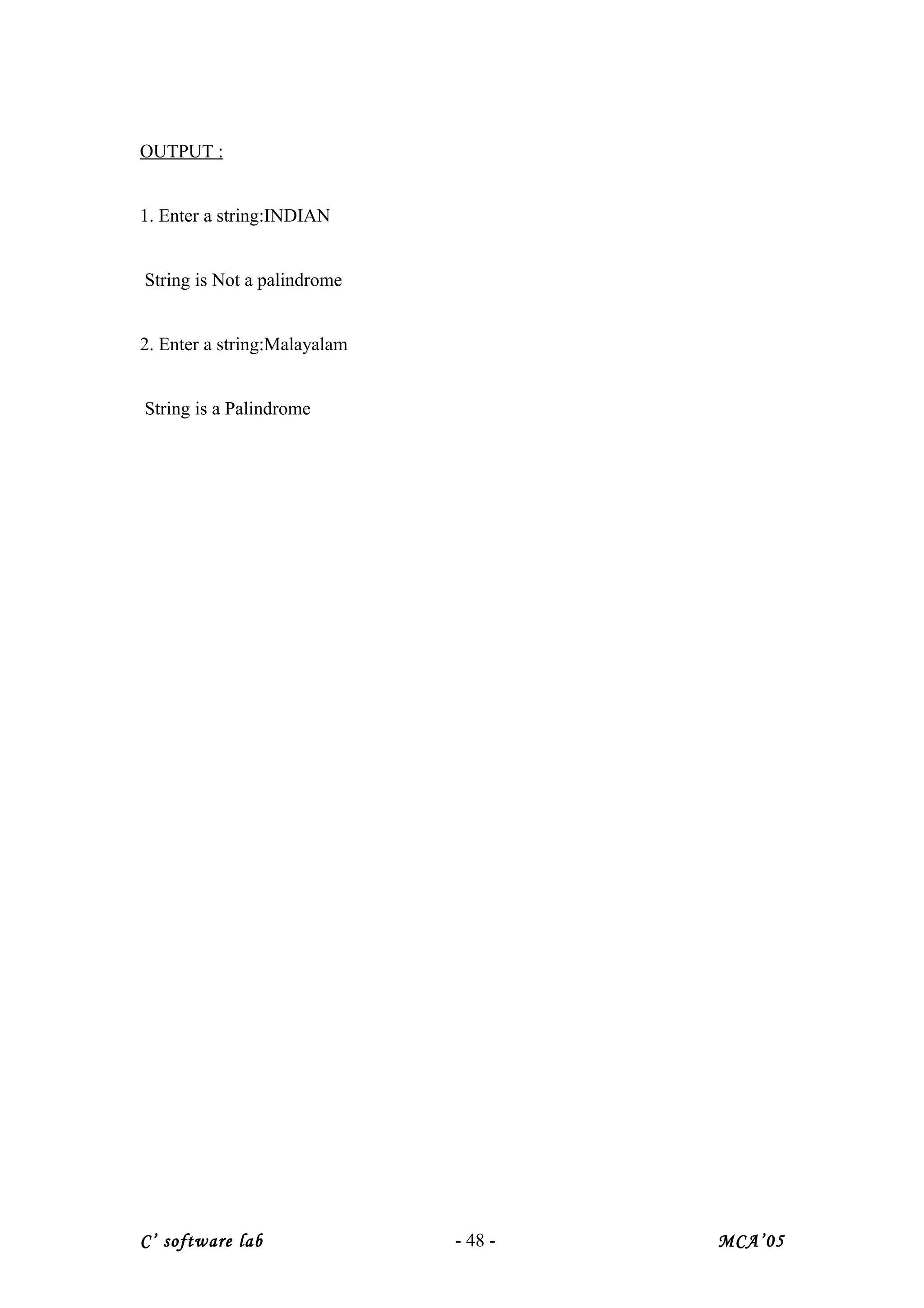
![Experiment No.14
Date:
AIM : TO COUNT THE VOWELS, CONSONANTS AND DIGITS.
ALGORITHM :
Step 1: Start
Step 2: Read str, vowc,conc,I,dig
Step 3: vowc o, conc0,dig0
Step 4: Input the line
Step 5: Print the given line
Step 6: lenlength of the string.
Step 7: Using for loop perform the step 7 to step 10 until len.
Check whether the a[I] is any of a,e,i,o,u if yes
vowcvowc+1 else go to step 8
Step 8: check whether the a[I]is between A and Z.
if yes concconc+1
Step 9: check whether the a[I]is between 0 and 9
If yes digdig+1
Step 10: print the vowc, conc, dig.
Step 11: Stop
C’ software lab - 49 - MCA’05](https://image.slidesharecdn.com/c-lab-programs-140703000544-phpapp02/75/C-lab-programs-49-2048.jpg)
![/*count vowels*/
#include<stdio.h>
#include<conio.h>
#include<string.h>
void main()
{
int i=0,j;
char a[100],c;
int chr=0,vow=0,dig=0,word=0,whites=0,others=0,cons=0;
clrscr();
printf("Enter a text: ");
scanf("%[^n]",a);
while((c=tolower(a[i++]))!='0')
{
chr++;
if(c== 'a' || c== 'e' || c== 'i'|| c=='o'|| c=='u') vow++;
else if(c >='a' && c<='z') ++cons;
else if(c>='0' && c<='9') ++dig;
else if(c==' ')
{
++word;
++whites;
while((a[i]==' ') || (a[i]=='t'))
{ i++;
whites++;
}
}
}
word++;
printf("n Entered String Consists of :n");
printf("nVowels =%d",vow);
C’ software lab - 50 - MCA’05](https://image.slidesharecdn.com/c-lab-programs-140703000544-phpapp02/75/C-lab-programs-50-2048.jpg)
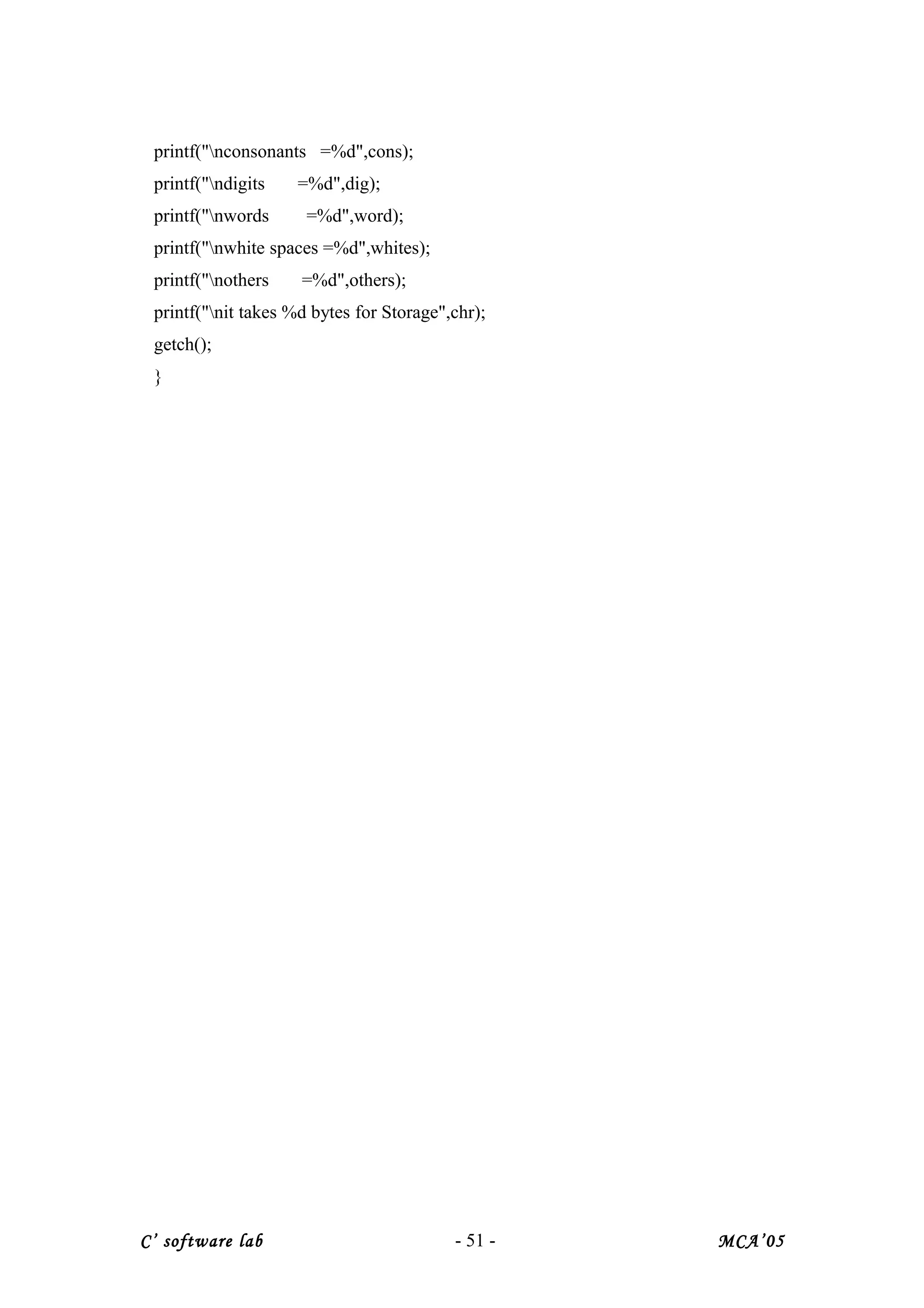

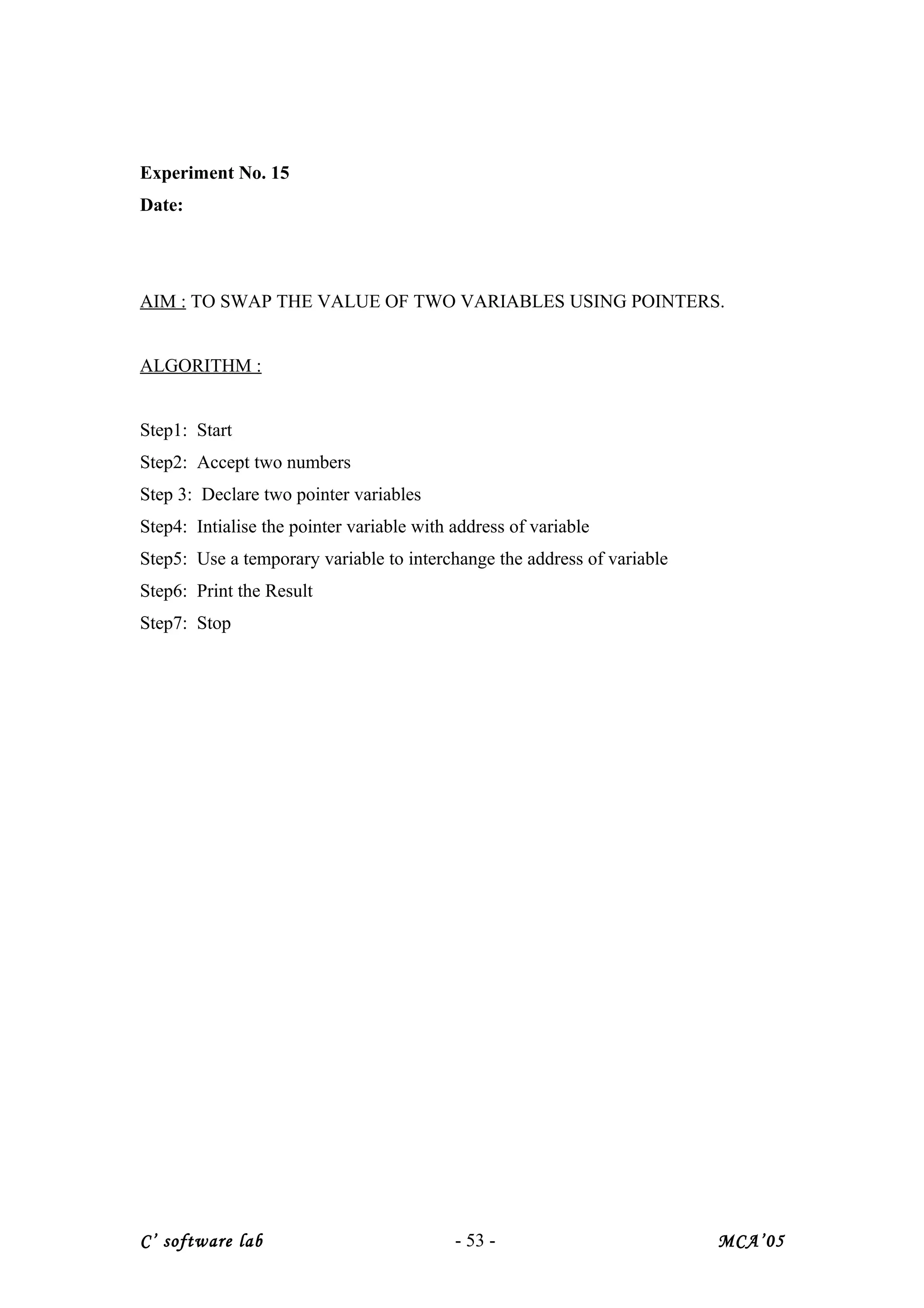
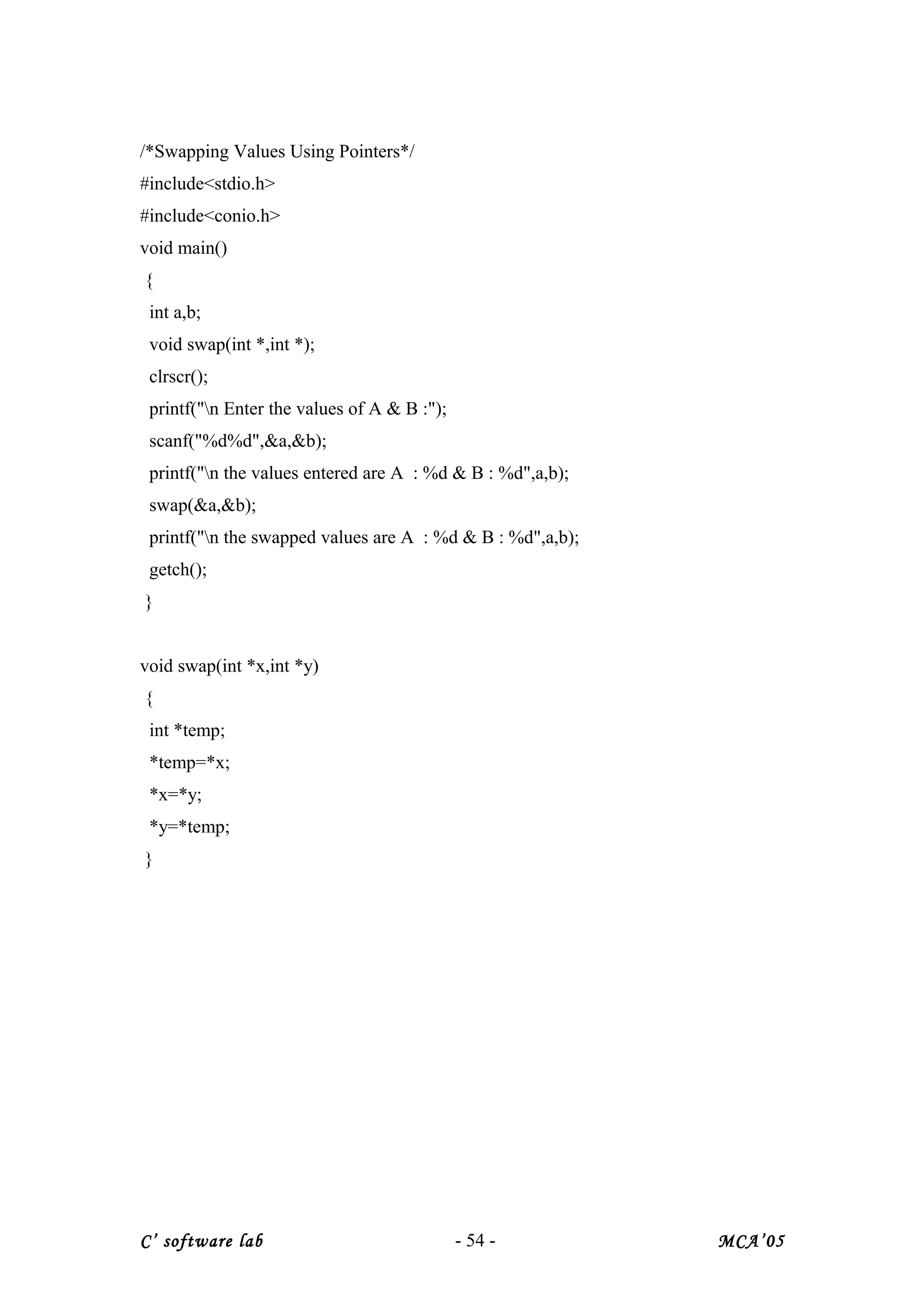
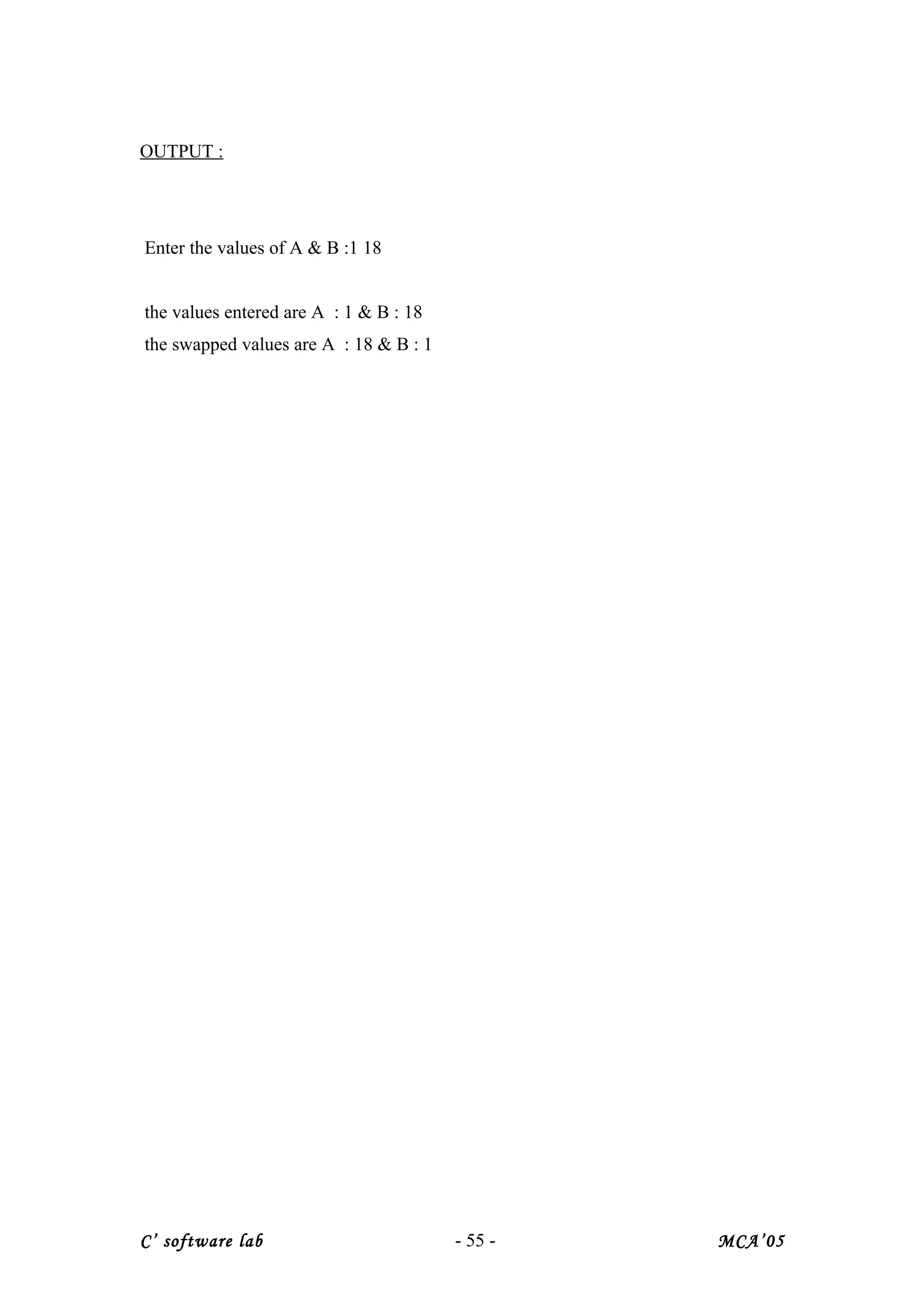
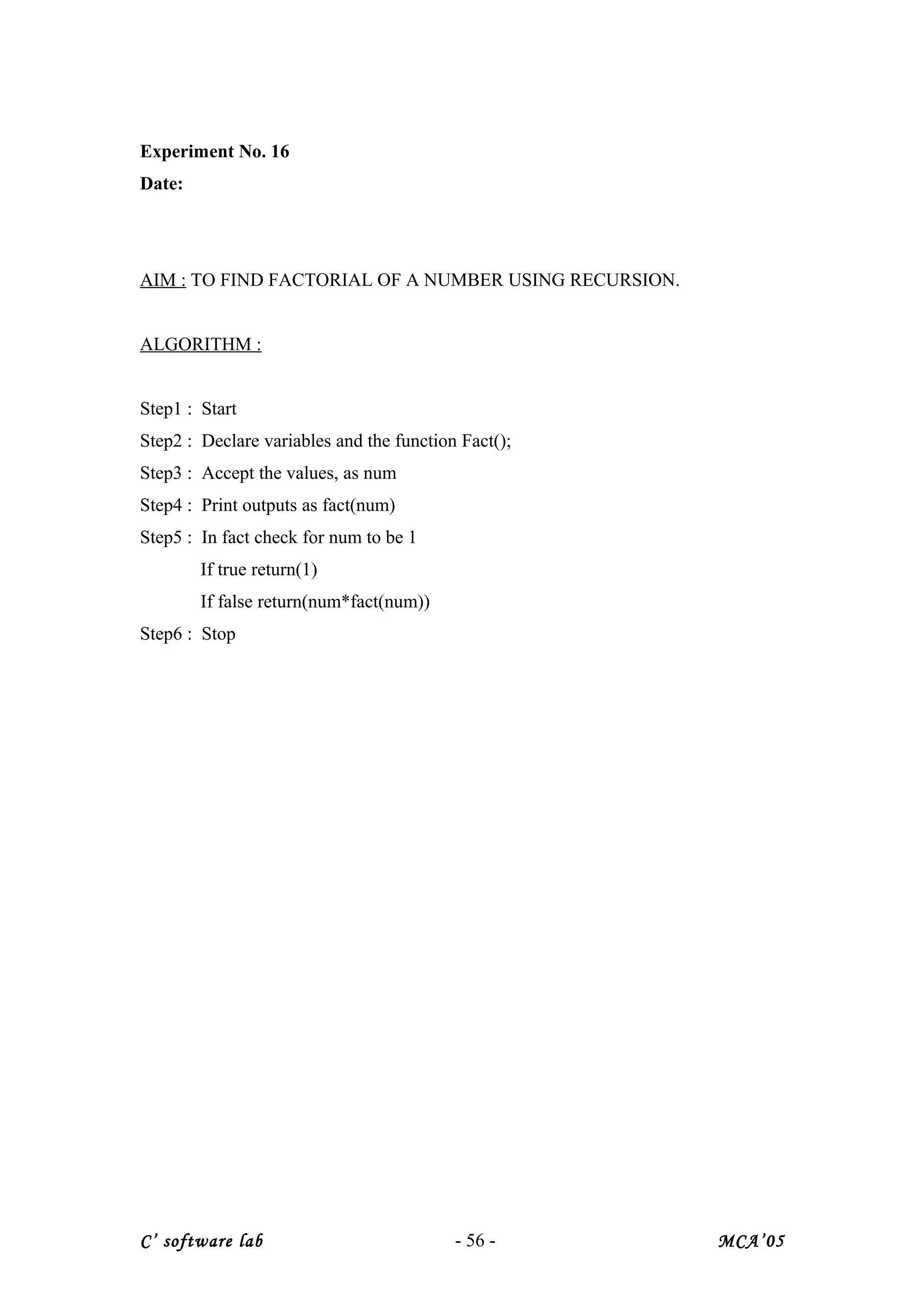
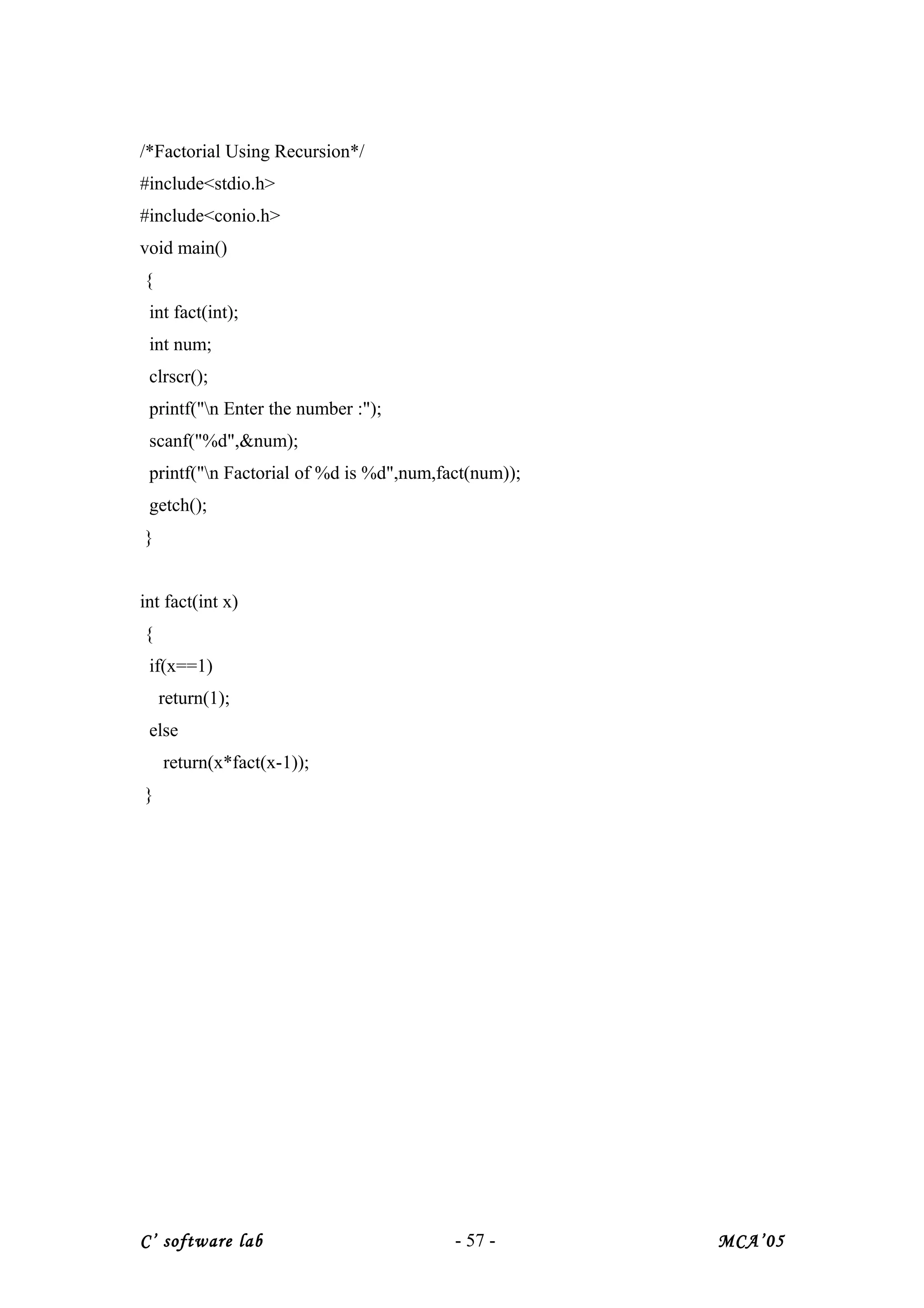

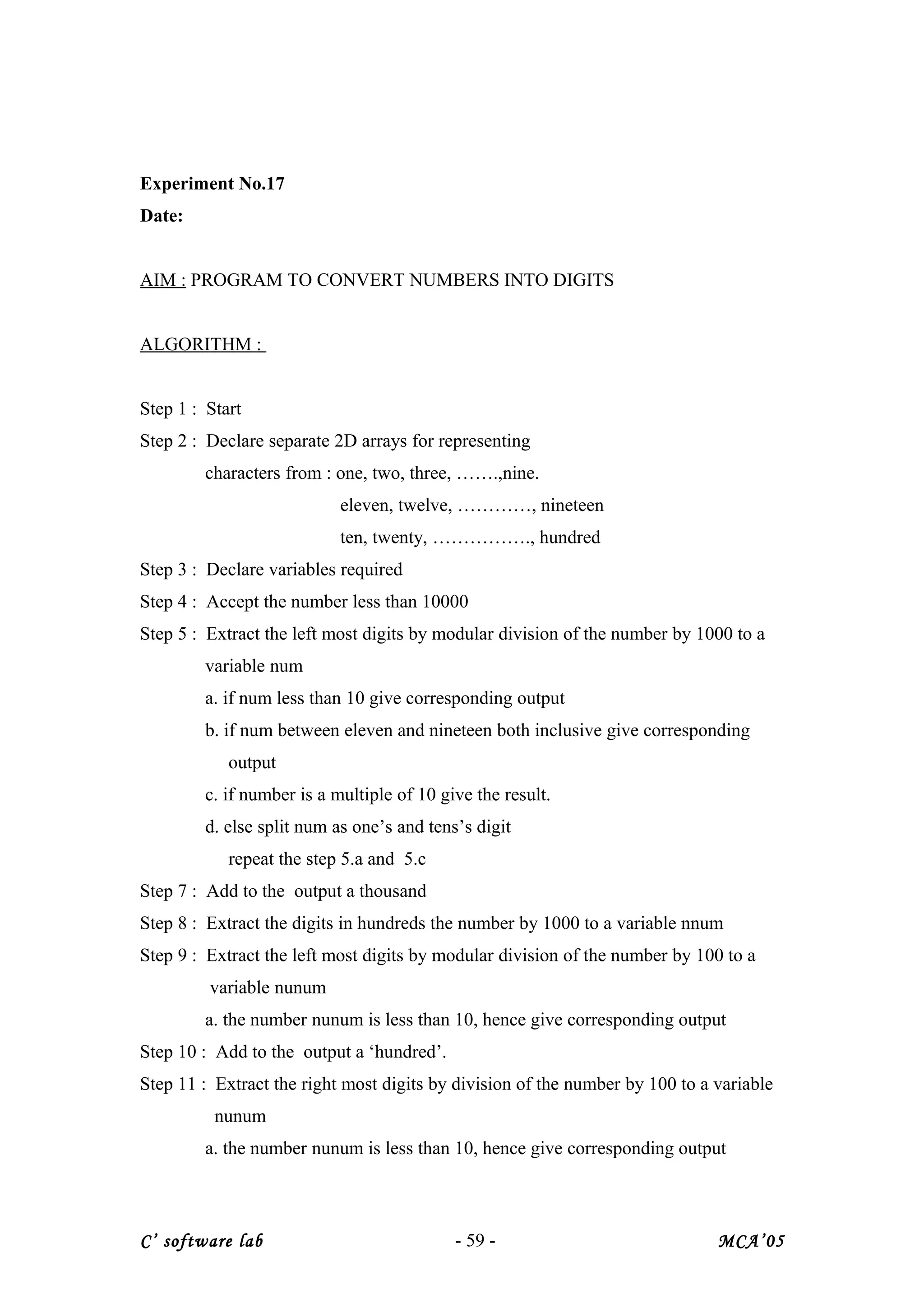
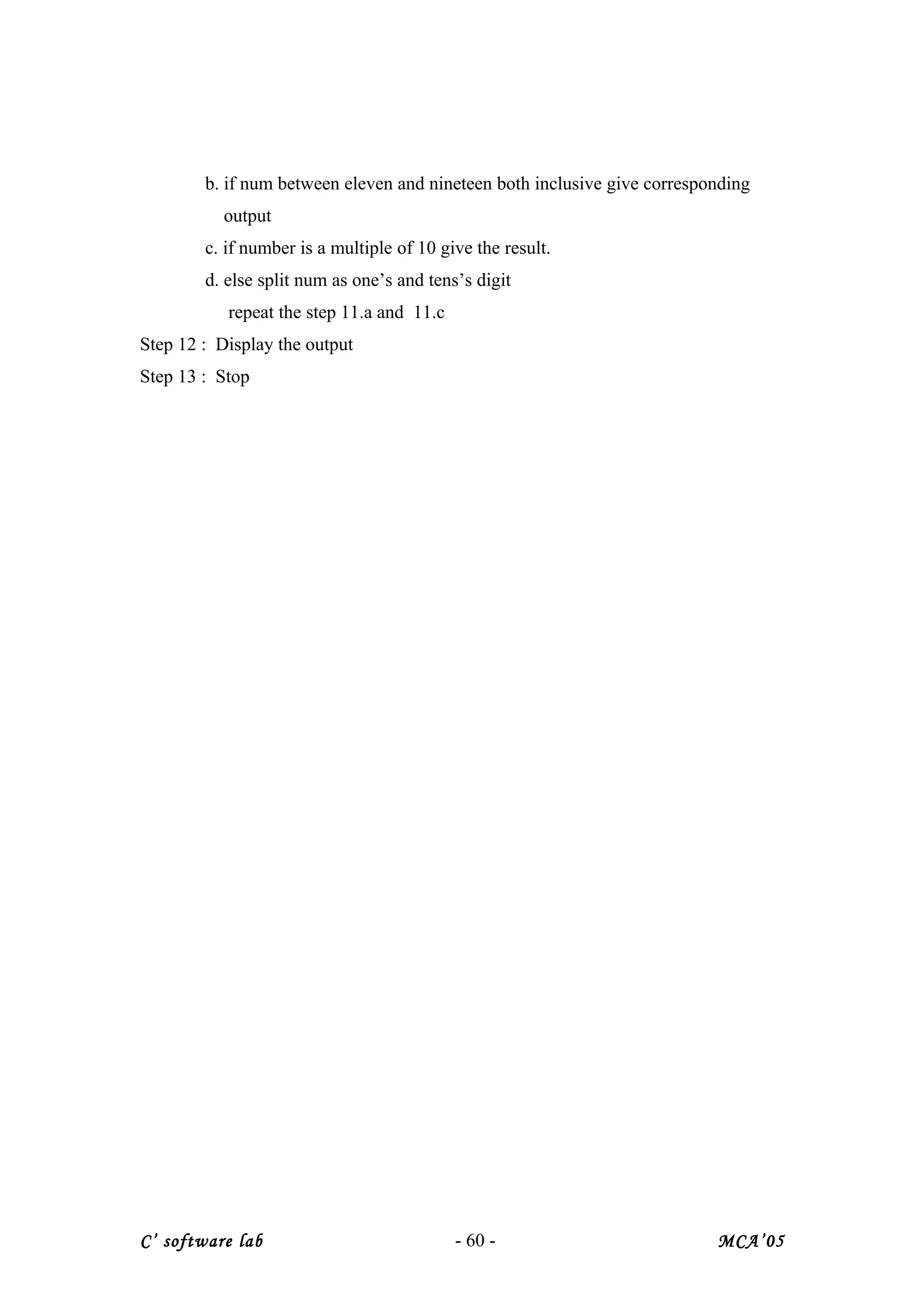
![/*convert figure into word*/
#include<stdio.h>
#include<string.h>
#include<conio.h>
void main()
{
char a[10][10]={"one","two","three","four",
"five","six","seven","eight","nine","ten"};
char b[10][10]={"eleven","twelve","thirteen","fourteen",
"fifiteen","sixteen","seventeen","eighteen",
"nineteen"};
char c[10][10]={"ten","twenty","thirty","forty","fifty",
"sixty","seventy","eighty","ninty","hundred"};
int r,s,t;
long n;
clrscr();
printf("Enter no.");
scanf("%ld",&n);
if(n>9999)
{
r=n/1000;
if(r>10 && r<20)
{
r=r%10;
printf("%s thousand ",b[r-1]);
}
else
{
s=r/10;
t=r%10;
printf("%s",c[s-1]);
printf("%s thousand ",a[t-1]);
C’ software lab - 61 - MCA’05](https://image.slidesharecdn.com/c-lab-programs-140703000544-phpapp02/75/C-lab-programs-61-2048.jpg)
![}
n=n%1000;
}
if(n>1000)
{
r=n/1000;
printf("%s thousand ",a[r-1]);
n=n%1000;
}
if(n>100)
{
r=n/100;
printf("%s hundred ",a[r-1]);
n=n%100;
}
if(n>10 && n<20)
{
r=n%10;
printf("%s ",b[r-1]);
}
if(n>19 && n<=100)
{
r=n/10;
n=n%10;
printf("%s",c[r-1]);
}
if(n>0 && n<=10)
printf("%s ",a[n-1]);
getch();
}
C’ software lab - 62 - MCA’05](https://image.slidesharecdn.com/c-lab-programs-140703000544-phpapp02/75/C-lab-programs-62-2048.jpg)
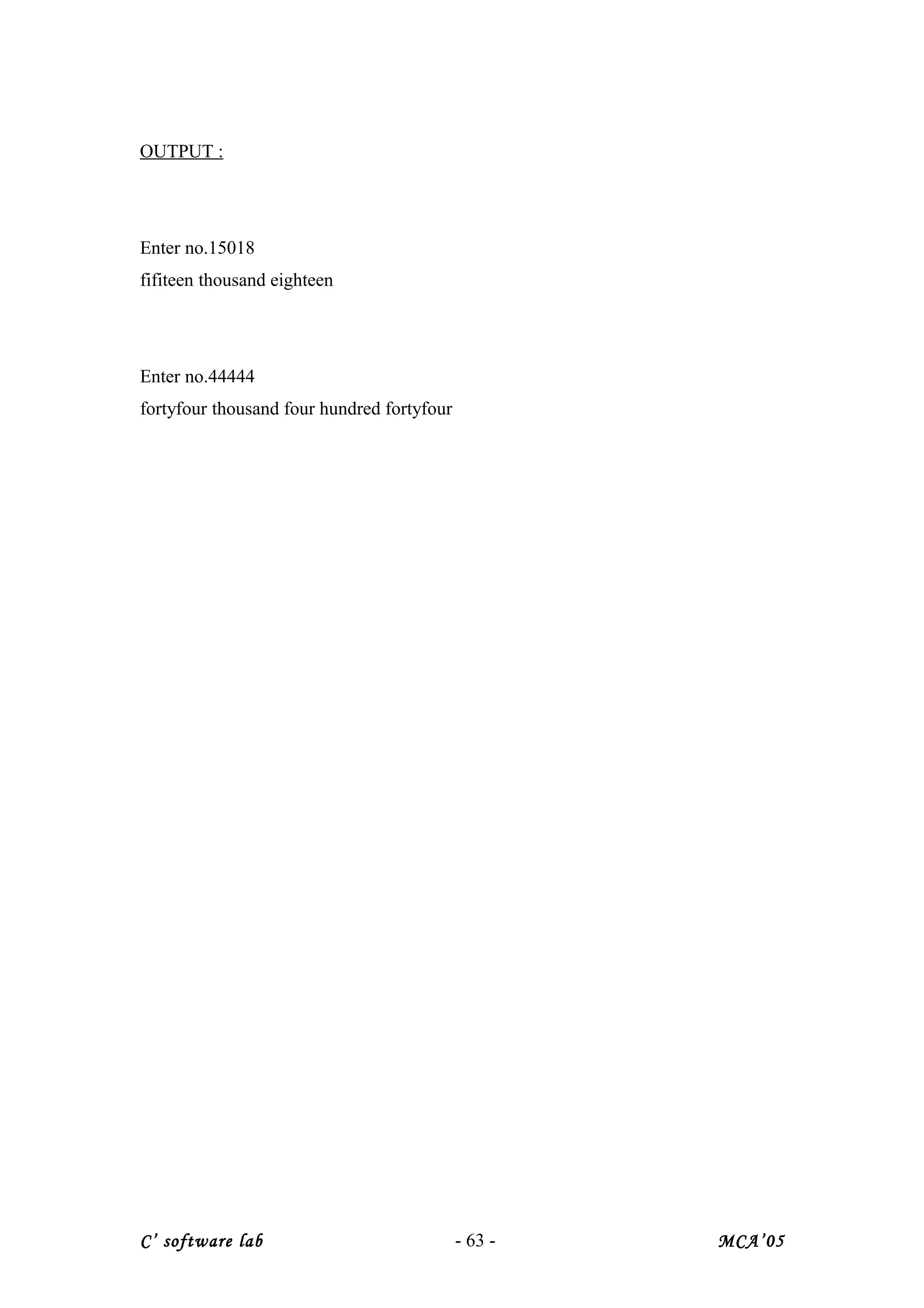
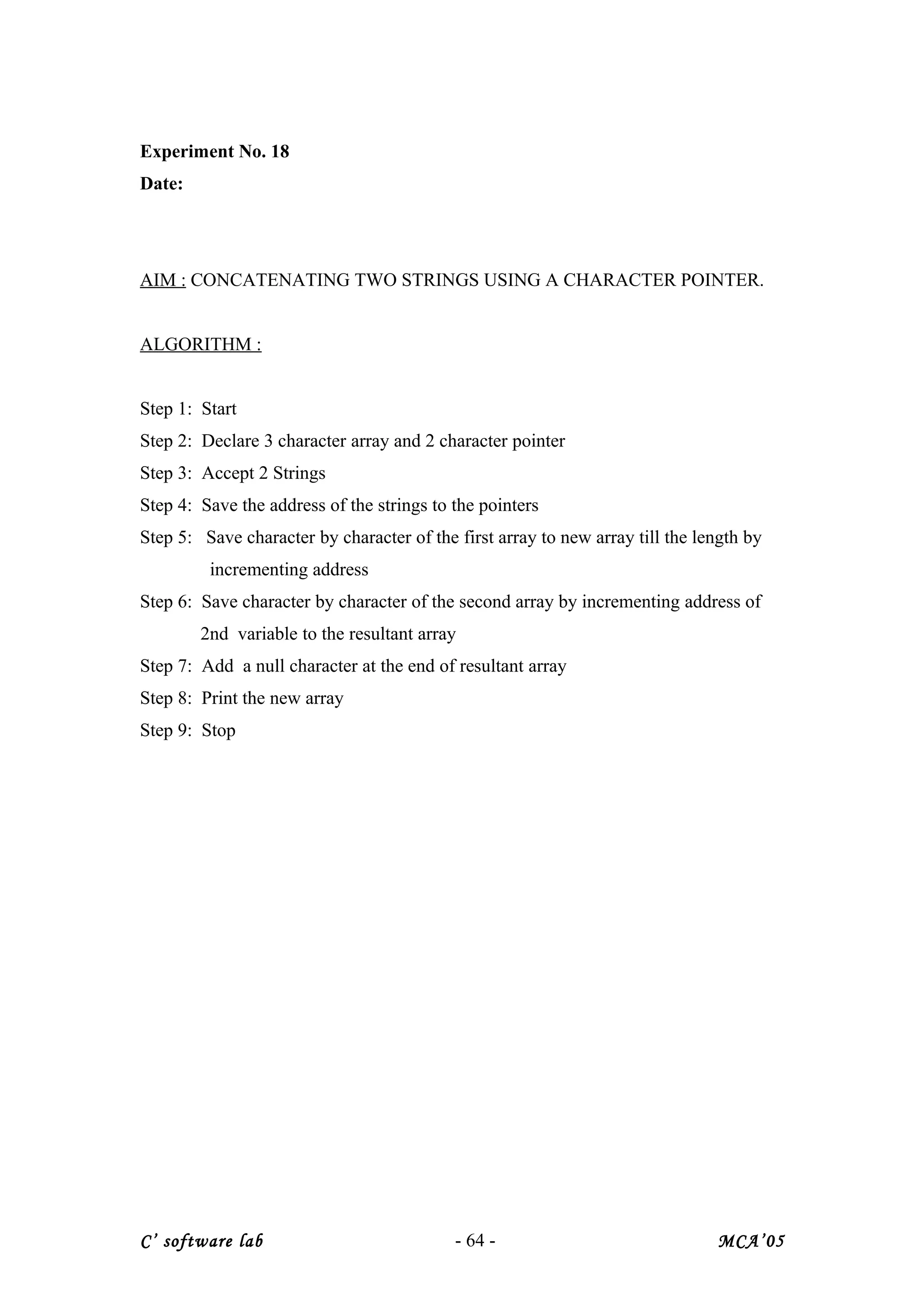
![/*String Concatenation using Pointers*/
#include<stdio.h>
#include<conio.h>
#include<malloc.h>
#define LEN 10
void main()
{
char *s1,*s2,*s3;
int i=0,j=0;
char c;
clrscr();
s1=(char *)malloc(LEN * sizeof(char));
s2=(char *)malloc(LEN * sizeof(char));
s3=(char *)malloc(LEN * sizeof(char));
printf("n Enter the First String :");
scanf("%s",s1);
printf("n Enter the Second String :");
scanf("%s",s2);
while((c=s1[i])!='0')
{
s3[i]=c;
i++;
}
while((c=s2[j])!='0')
{
s3[i+j]=c;
j++;
} s3[i+j]='0';
printf("n Entered Strings '%s' and '%s' are concatenated to ...%s",s1,s2,s3);
getch();
}
C’ software lab - 65 - MCA’05](https://image.slidesharecdn.com/c-lab-programs-140703000544-phpapp02/75/C-lab-programs-65-2048.jpg)
